The IDEFA Journal
Indiana Deer & Elk Farmers’ Association

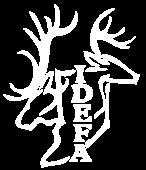

IDEFA ANNUAL PICNIC & FUNDRAISER!
SPONSORSHIPS, DONATIONS, FARM TOURS, AND MORE!
BLUE CREEK WHITETAILS
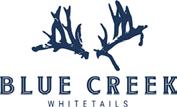
FOCUSED ON PRODUCING ELITE WHITETAILS


CLINTON PRAIRIE WHITETAILS
Dedicated to Raising Wide Typicals
PINE CREEK CHAIN LINK
DEDICATED TO MEETING THE DEMANDS OF THEIR CUSTOMERS
Summer 2023 l Volume 11 l Issue 2
SUDDEN EXPRESS / FREEZE FRAME / G HAMMER / TASHA 348” @
2
you ready FARM STORY & ADS INSIDE
Are

2022-2023 IDEFA Board of Directors
President
John Stoltzfus
5 Star Genetics
5835 N 1000 W
Shipshewana, IN 46565
Phone: (574) 596-2347 jdwhitetails@gmail.com
Vice president
Lester Eicher
Springfield Whitetails
14905 Springfield Ct Rd
Grabill, IN 46741
Cell: (260) 341-3614 springfieldwts@gmail.com
Secretary/Treasurer
Earl Hershberger
Clear Creek Whitetails
6960 W 200 N
Shipshewana, IN 46565
Cell: (260) 350-3506
Fax: (260) 768-4761 earlcvpg@yahoo.com
Director
Heath Alexander
Forgotten Mile Whitetails
6675 W 500 N
Pennville, IN 47369
Cell: (260) 341-7296
Email: thaeh80@gmail.com
Director
Josie Borkholder
Lone Pine Whitetails
1656 2B Rd
Bremen, IN 46506
Home: (574) 248-2675
Fax: (574) 546-4211 josie@pinecreekchainlink.com
Director
Nelson Miller
Antler Ridge Whitetails
71396 CR 25
New Paris, IN 46553
Cell: (574) 312-1349
Fax: (574) 538-2105 nelmiller26@gmail.com
Director
Dr. Darryl Ragland, DVM, Phd
625 Harrison St
West Lafayette, IN 47907
Home: (765) 494-3234
Cell: (765) 418-5673 raglandd@purdue.edu
Director
David Schwartz
Shallow Pond Whitetails
3990 N 675 W
Shipshewana, IN 46565
Cell: (260) 336-1687 shallowpondwts@gmail.comt
Director
Jerry Schwartz
Countryside Whitetails
10852 W 900 N
Bourbon, IN 46504
Cell: (574) 907-9457
Fax: (574) 546-0390
Director
Lonnie Whetstone
Whetstone Brothers Premier Whitetails
228 Ply-Goshen Trail
Nappanee, IN 46550
Phone: (574) 248-9188
Fax: (574) 773-2371
Office@WhetstoneBrothers.com
Director
Lance Whitsell
Valhala Farm

1277 West Scratch Gravel Rd
Liberty, IN 47353
Phone: (513) 839-5001
lance.whitsell71@gmail.com
Director
Rober Yoder
Cedar Road Deer Farm
6664 Cedar Rd
Bremen, IN 46506
Phone: (574) 646-2504
byoder@hardwoodinterior.com
**Erica Bratton (574) 220-5652 ~ indianadeer@gmail.com
IDEFA Committees: 2022-2023
Hunting Preserve/Legislative
Chair: Dr. Ragland Committee: Andy Aker, Lance Whitsell
Public Relations
Chair: Lester Eicher Committee: Trevor Vance
Audit/Ethics & Bylaws
Chair: Josie Borkholder Committee: Robert Yoder
Fundraisers/Summer Picnic
Chair: Josie Borkholder Co-Chair: Lonnie Whetstone
Member Relations: Erica Bratton Food: Jerry Schwartz Committee: Earl Hershberger, Nelson Miller, Brian Bratton, John Stoltzfus, Robert Yoder, Heath Alexander, David Schwartz, Lance Whitsell.
Budget Committee
Chair: Earl Hershberger Committee: Nelson Miller, David Schwartz
IDAC
Chair: Dr. Ragland Committee: Shelly Chavis, Shawn Schafer
1

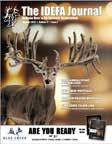





3 ADVERTISERS INDEX AR&R Antler Replica & Repairs 23 Backyard Whitetails 13 Blessed Bayou 46 Blosser Whitetails 27 Blue Creek Whitetails Cover, 2, 12 C&E Wildlife Products 36 Cedar Road Deer Farm 5 Cervid Central Market Place 32 Cervid Solutions, LLC 22 Clay Kuntry Whitetails 49 Clear Creek Whitetails 52 Clinton Prairie 20 CuddliEZ 57 D&M Whitetails 25 Dan-Inject North America 28 EZid, LLC ..................................................... 13 Fox Valley Animal Nutrition, Inc 41 Head Gear, LLC 11 Hilty Whitetails 55 Horizon Whitetails 18 Illini Whitetails 16 Jo Jo’s Whitetails 17, 34 Lambright Whitetails In. Back Cover Major League Whitetails 58 NexGen Animal Health 59 Pine Creek Chain Link ................................ 9 Pine Creek Deer Farm 38 Pneu-Dart 45 Prime Acres Whitetails 43 Purina 51 Rocking JE Whitetails 48 Rocky Ridge Whitetails 44 Rolling Acres Whitetails 33 Shallow Pond Whitetails 40 Springfield Whitetails Back Cover, 56 The Forgotten Mile 53 Thompson Trophy Whitetails 37 Trophy Whitetails 29 Walnut Ridge Whitetails 57 Whitetail Sales & Auction In. Front Cov. Woodard Whitetails 30 Yoder Brothers Whitetails 36 Zehr Bros Whitetails 26 IN EACH ISSUE Activity Pages 39, 47 Administrative Report 4 Board of Directors 1 Business Cards 42 Membership Application................................................................ 50 Necropsy Submission Form 60 Presidents Message 4 Recipe - Spring Salad with Venison & Roast Radishes ........... 35 CONTENT FEATURED ARTICLES: Effective Bottle Feeding Tips from Woodard Whitetails 31 Fallow Deer Gaining in Demand and Popularity ....................................... 24 Invest in Semen Straws Wisely and Thoughtfully ..................................... 54 Meet The Team - Sam 10 TDA - North American Deer Talk with Kevin Davis 23 IDEFA: Blue Creek Whitetails – Focused on Producing Elite Whitetails ..... 14, 15 Clinton Prairie Whitetails – Dedicated to Raising Wide Typicals 21 IDEFA Event Information 6, 7 Pine Creek Chain Link – Dedicated to Meeting the Demands of Their Customers 8 Updates From BOAH - Moving Cervids to Kentucky 19, 20 Fall Deadline Aug 23rd GRAPHIC DESIGN AND PUBLISHING Kathy Giesen, Editor/Publisher 305 E. 350 N., Ivins, UT 84738 deerassociations@gmail.com 435-817-0150 • Fax: 435-359-5333 Website: deersites.com (Editorial Provided by Contributing Writers) Insert: Auction Book Advertising Sponsor Form Magazine Advertising Rates Donation Form Quarterly Calendar Showcase Book Advertising Advertising Guide
PRESIDENT’S MESSAGE
Hello Fellow IDEFA Members,
By the time you read this journal edition, new fawns should be coming to an end. I hope had great success. Now onto watching them bucks grow, it’s always a very exciting time of year.
Around the corner is the IDEFA Annual Summer Picnic. This year it will be held in Nappanee. Looking forward to seeing everyone there. IDEFA will have many great giveaways and prizes.
Bring your antlers for the competition. Every year the Board Members try to make it bigger and better. This year there will be some new things, but you need to be there to experience it.
Saturday will be the 2nd Annual IDEFA Farm Tour. Last year was a great success. Make sure to include the tours in your weekend. There will be food and drinks along the way!
Thank you, Your
President
John Stoltzfus
ADMINISTRATIVE REPORT
Hello to All!
Wishing you all had a good fawning season and hoping your bucks are growing good.
Just a reminder that memberships run from January 1st to December 31st. If you have not yet renewed for 2023, please take the time to fill out your form located in this book and send in to keep up on all the happenings.
We will also start including a copy of the Necropsy form in each journal. There have been some misconceptions in the program, please be sure to use this form to ensure that your reimbursement will be seamless. If you have any questions, please feel free to contact me or any Board member.
Mark your calendars for August 4th for our Annual Meeting, Picnic and Fundraiser. If you have any suggestions and/or wish to volunteer, we would love to have you! If you’d like to be on the ballot for a Board position, please let us know!
Wishing everyone a successful fawning season
Erica Bratton
 Administrative Secretary
Administrative Secretary
Cell: 574-220-5652
Fax: 952-955-6022
indianadeer@gmail.com

Watch for These Symbols
- these are interactive links in the eBook that is sent out to all members
This symbol indicates there is a video linked
This symbol indicates there is a link to an email, website, or facebook page
4







Breeding For The Hunter’s Satisfaction Silver Factor / loneStar / QuickSilver ROBERT & GILBERT YODER 574-646-2504 BamBi expreSS / QuickSilver / Blazer Black Hawk BamBi expreSS / Silver king / SilverStorm @ 5 @ 3 @ 3 Semen AvAilAble Semen AvAilAble AvAilAbilty Pending


PINE CREEK CHAIN LINK DEDICATED TO MEETING THE DEMANDS OF THEIR CUSTOMERS
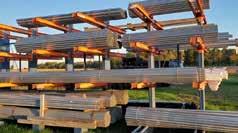 By: Gail Veley
By: Gail Veley
Pine Creek Chainlink fencing company manufactures and sells custom chain link fence. From the height of the fence to the size of the weave or holes, Pine Creek Chainlink, located in Bremen, Indiana, is busy meeting the needs of their growing customer base, including some in the deer industry. Chain link fence, known for its durability, longevity and low maintenance appeal, is not just a wise purchase. “It’s an investment that will pay for itself over and over again,” said Owner Josie Borkholder.
Chain link fencing is available in either prime (shiny or primary wire) or subprime (less shiny or secondary) wire. While subprime wire may cost less than prime wire, it is not less durable or strong. “Most deer farmers use the subprime as it is good enough for them,” Borkholder said. “Overall, it’s much safer because fawns can’t stick their heads through it, ear tags can’t get ripped off by it and antlers can’t get stuck in it as easy.” Whether it’s eight, 10 or 12-foothigh fencing you are after, Pine Creek Chain Link can produce what you need along with custom gates (from walk through to big traffic) and galvanized steel posts.
Since 2018, Pine Creek Chain Link has offered high-quality chain link fence. However, given their current ability through machinery purchases to produce their products directly on site, means the ball is in their court. “We aren’t waiting on anyone else to supply us with what we need. We have it all right here. This allows us to be very competitive. We’ve even been known to drop what we’re doing and do rush orders,” Borkholder

said. “We had a fence contractor from Michigan call us who needed 200 feet of fencing. When I asked him how soon he needed it he basically said ‘yesterday.’ By the time he drove down that same day from Michigan, we were just finishing up with his order.”
In addition to meeting customer demands, Pine Creek also provides and installs privacy slots, long slender plastic tubing material, that can be woven through the chain link slats to create a more solid looking fence. “This is very appealing to many customers and to deer farmers looking to provide shade or privacy for their deer,” Borkholder said.
In the years that Pine Creek Chain Link has been in business, they’ve grown from operating out of a 16 x 32-foot portable shed to operating from a 3,200 square foot warehouse. They also lease
another building at a second location for material storage and maintain a sizable inventory outside of their primary location. “We have grown quite a bit. We now have four employees and are very happy with our ability to produce a product we all can stand behind,” Borkholder said.
Anyone interested in learning more about chain link fence and how it could work for you, can call Josie Borkholder at 574-301-5900 Ext. #2 or Lyndon Miller Ext. #1. They are open from 6 a.m. to 3 p.m. Eastern Standard Time.
8
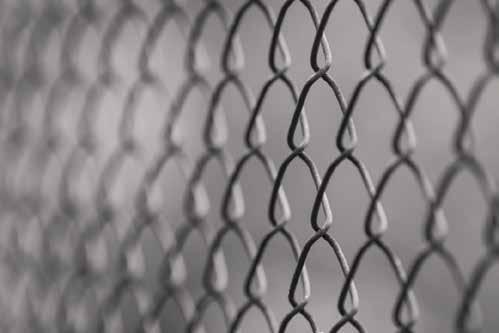

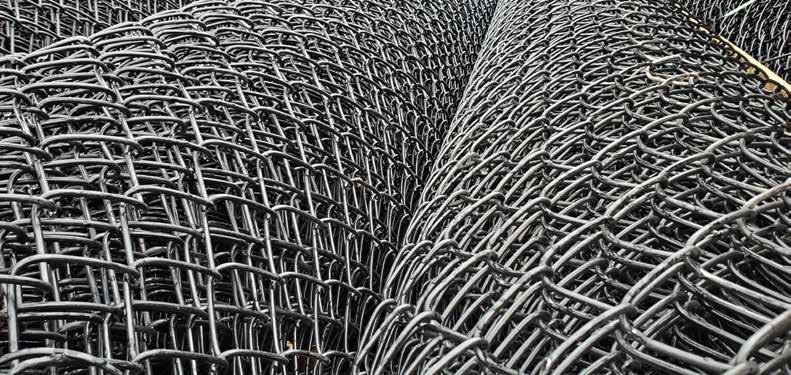

Meet the Team

Meet Our Customer Care Representative ~ Samantha (Sam) Uchytil
 By: Gail Veley
By: Gail Veley


entrenched in the industry, is anxious to help deer farmers reinvest in their business through advertising in state deer association magazines. Her journey began years ago when as a young girl, she held a bottle for her first personal deer, Mocha (a.k.a. Purple #3). In that moment, Sam, the daughter of Steve and Melissa Uchytil of Crow River Whitetails in Atwater, Minnesota, knew where her heart was leading her. Now, at age 29, Sam has recently stepped in to join the D & K Design Team as a Customer Care Specialist and bring even more breath and vitality to each quarterly deer association magazine.
“I’ve worked the registration desk at Minnesota deer association events for about 10 years and because of that, made a lot of friends,” Sam shared. “I love working with deer and the opportunity to be an active industry member in this new role.” Choosing Sam for the position came easily for D & K Design Magazine Editor Kathy Geisen, who felt that Sam’s ability to connect and relate to those in the industry made her a perfect fit.

very personable,” Geisen said. “Whether you have been in the industry for a long time or are a newcomer, Sam can relate to your goals and needs.”
While the goal of advertising is to showcase your products and services, it’s also to maintain a consistent presence to those seeking what you have to offer. “I’m excited and feel very fortunate to make this my full-time endeavor,” Sam said. Thus far her favorite ads are those featuring bucks, followed by ads pertaining to antler replication, food plots and nutrition.

When she isn’t working with clients, she enjoys long-distance competitive running, gardening, maintaining an orchard at her cozy 500-square foot home in New London, Minnesota and spending time with her three dogs. They include her chihuahua “Lucky,” a heeler mix named “Ringo” as well as a husky/ shepherd mix named “Finn.” Sam also enjoys spending considerable time at Crow River Whitetails, hanging out with hunters and seeing the results of their hunts. While she
small game such as rabbits and squirrels. As she sets her sights on her next hunting adventure, she also is setting her schedule to attend future industry events and expanding her circle of friends and clients whether they be from Florida, Texas, Michigan, New York and everywhere else in between.
“This is a dream come true for me,” Sam said. She can be reached by calling or texting her at 320-905-2622 or emailing her at samuchytil@gmail.com. “I’m looking forward to working with all of you.”
Give Sam a call or email her: deerassociations@gmail.com 320-905-2622
Our ‘Meet the Team’ series continues! Each member of our D&K Design publishing team will contribute an article. New team members and existing will update our viewers on what goes on in the back ground of these published newsletters. Stay tuned!
Look forward to meeting you! ~ Sam
10
“Mocha”
Science that delivers the health & productivity you require



G FORC E™
SCIENTIFICALLY FORMULATED NATURAL SUPPLEMENT TO HELP GROW LARGE, HEALTHY DEER AND BIG ANTLERS!
Nutrient rich formula contains highly bioavailable ingredients, including our proprietary calcium/phosphorous complex with Antler D TM, that are required to support body and bone growth, especially for fast growing bucks

Contains probiotics and targeted enzymes to support gut health and proper digestion
Available in pellet or powder that can be top dressed or mixed in feed. Great for antler growing season and young bucks, too


PRECISELY FORMULATED TO HELP MAINTAIN A NORMAL AND RELAXED DISPOSITION IN ALL CERVIDS
Provides optimal levels of magnesium, Vitamin B1 and inositol to promote calmness and provide help for restless animals
Contains no herbals, tryptophan or chemicals, eliminating concerns of unwanted side effects
Use PeaceMaker to “keep the peace” during pre-rut, rut, transportation, weaning and anytime destructive behavior may occur
ENTERIC HEALTH FORMULA
POWERFUL SOLUTION FOR HEALTH & PRODUCTIVITY

Helps maintain digestive health and productivity
Contains micro-encapsulated probiotics, targeted enzymes and a novel fiber complex
Use in does before fawning, during lactation and all cervids during times of environmental stress

FAWN ARRIVAL™ POWDER & PASTE
HELPS PRODUCE HEALTHY, FAST GROWING FAWNS
Helps maintain normal digestive health
Supports a healthy immune system
Feed powder for 14 days to bottle fed fawns
Paste is ideal for fawns left on does

™
FAWN & DEER XTR
ROBUST FAST RESPONSE FOR FAWNS & OLDER DEER
Innovative formula delivers max digestive support, especially in newborns
Rapidly delivers help for GI health and a functioning immune system
May also be used post-tranquilization to support healthy recovery
11 IDEFA 2022
PeaceMaker™
Science Geared For Deer H ead G ear LL c 1383 arcadia road , suite 102 / L ancaster , pa 17601 p H one 717-509-5724 www . H ead G ear LL c . com scan to L earn more
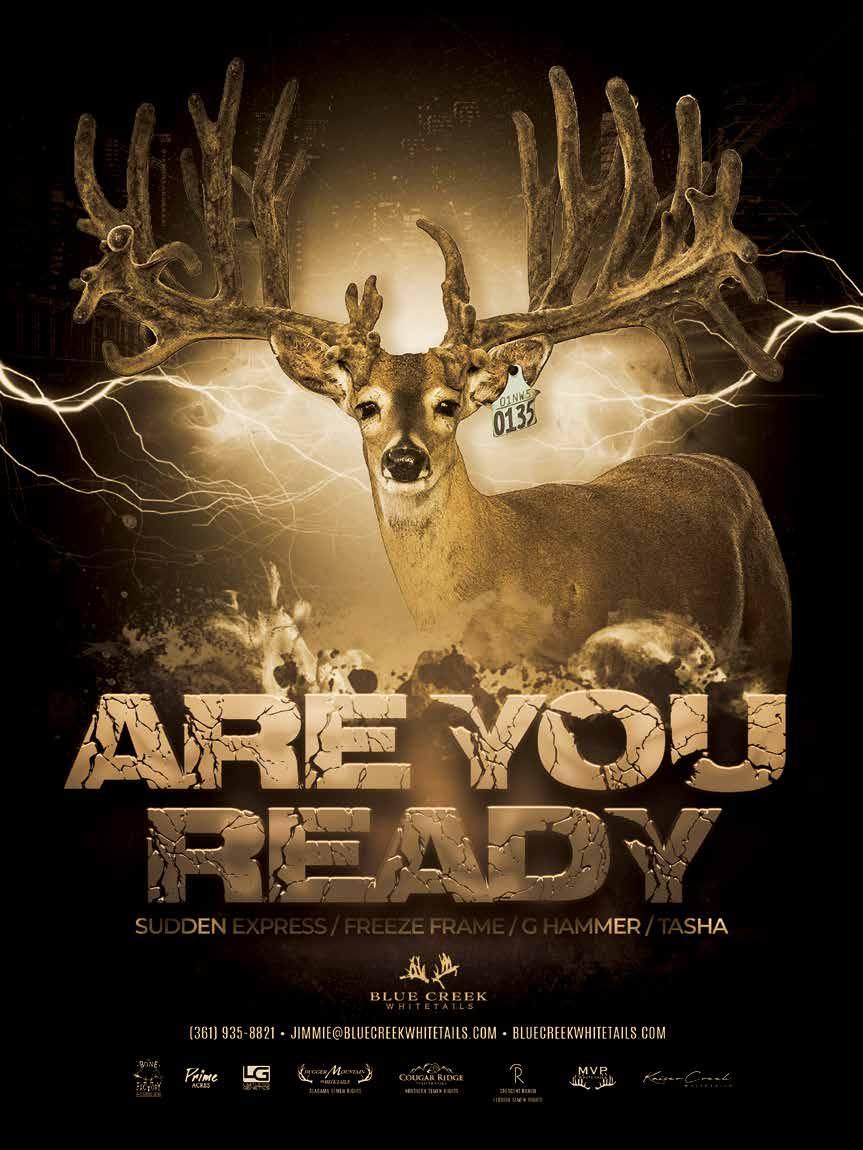
Micr ochips
• USDA 15 digit ISO
• 9 digit Avid and 10 digit Euro. Avid Reader s


• Avid MiniTracker Livestock Reader specially priced.

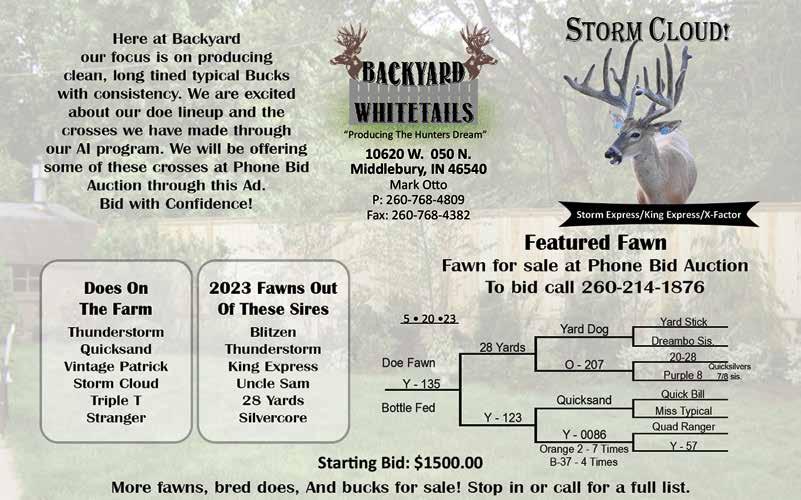
• Blue Tooth® option.
• Dependable Fast, Accurate read EVERY Time!
• U.S.A. made and service.
Coupon: event 21 Limited time offer mention this ad for discount $ave Huge on MiniTr acker Reader and Save $10 on 25 microchip SUDS
Mention this ad And SAVE $10 on $200 or more purchase. For limited time only.

13
BLUE CREEK WHITETAILS
FOCUSED ON PRODUCING ELITE WHITETAILS
By: Gail Veley
Blue Creek Whitetails Manager
Jimmie Neeley pauses at the pen of Royal, his favorite doe on the farm he breathes life into seven days a week. As Royal approaches him, it isn’t so much the treat he’s holding that she’s interested in, but rather, the affection he offers along with it. She nuzzles and licks his hand as he strokes her neck and softly talks to her. Her sheer delight in seeing him is obvious. And vice versa. And just like the farm itself, there is a lot to appreciate about Royal, whose pedigree includes Blue Chip, Freeze Frame, Shadow and Tasha among others. This four-year-old doe is also perhaps a symbol of what is good and right in the deer industry
and at Blue Creek Whitetails. Their superior animal husbandry skills combined with breeding superior genetics, finds Blue Creek Whitetails producing some of the most elite whitetails in the industry.


The sprawling 250-acre farm in Falfurrias, Texas, is home to approximately 1,150 deer including bucks and does. What that number does not include is the 400-500 fawns expected this season. And while those sheer numbers of deer may seem overwhelming from a management perspective, Neeley, who always keeps the big picture in the back of his mind, lives by this decree. “We take things one step at
a time and one deer at a time,” he explained. “You don’t only focus on the big picture. You learn to slow down and simplify and to keep your goals clearly defined. We have a great team of employees that always goes above and beyond in every circumstance.”
Neeley and his wife Kayla are as devoted as anyone could be in their positions. Yet, both realize how lucky they are to have the dedicated team of employees working right alongside them. “We have one gentleman working here that no matter what time you decide to start that day, he always the first one there. He refuses to show up second to work,” Neeley, 41, shared. “We also have an employee who’s a licensed veterinarian in Mexico. After seeing to the deer, he’s not one bit scared to work hard and pick up a weed eater or get on a tractor. He’s 70 years old and he’s amazing. All of the employees here are amazing and work together seven days a week. Every one of them is a valuable asset. We deeply appreciate everything that they do.”
Neeley, along with farm owners Billy and Alice Oehmig, also appreciate the partnerships they have on a few prized breeding bucks. These include Ice Man with Jade Webster of MVP Whitetails, Simply Irresistible and Wanted with Brad Hassig of Prime Acres as well as Are You Ready with MVP Whitetails, Prime Acres, Jesse Boger of Limitless Genetics, Kiser Creek and Billy Sage. “With our business partners and
14
Simply Irresistible
production record, we believe we are moving in the right direction,” Neeley said. “Our customer base is growing immensely. They are extremely important to us along with building and maintaining good relationships. We do everything we can to make things right. And we are always looking to improve and make the herd better.”
In their spare time the Neeley’s enjoy going to the beach and also going to the gym to workout. Yet, coming back home to the farm is a feeling unlike any other. At the end of the day, crimson colors cascade as the perfect backdrop to a pen with 100 does thriving among evergreen live oak trees endemic to the Texas terrain. From his back porch Neeley takes the sight in, which never gets old. He lets out a grateful sigh that another day has gone well at this deer paradise. As he lays down next to Kayla and prepares for a good night’s rest, his last waking thought has been known to be “How can we grow bigger deer?” Check out Blue Creek Whitetails on Facebook as well as their website www. bluecreekwhitetails.com.
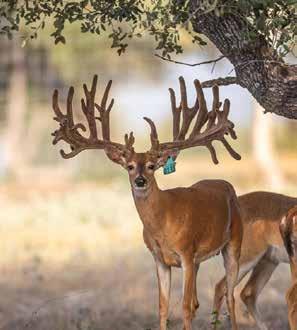
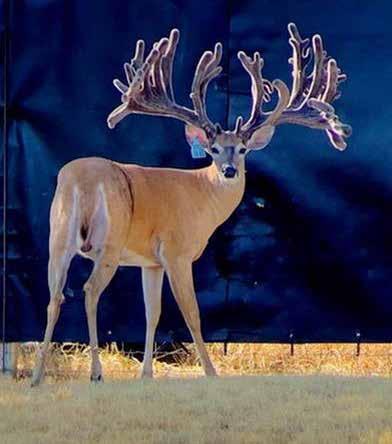
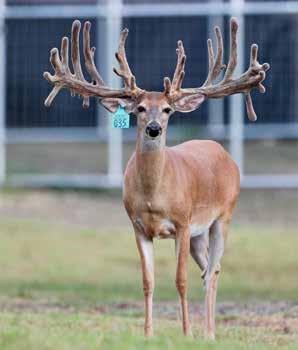
15 Wanted
Are You Ready
Iceman
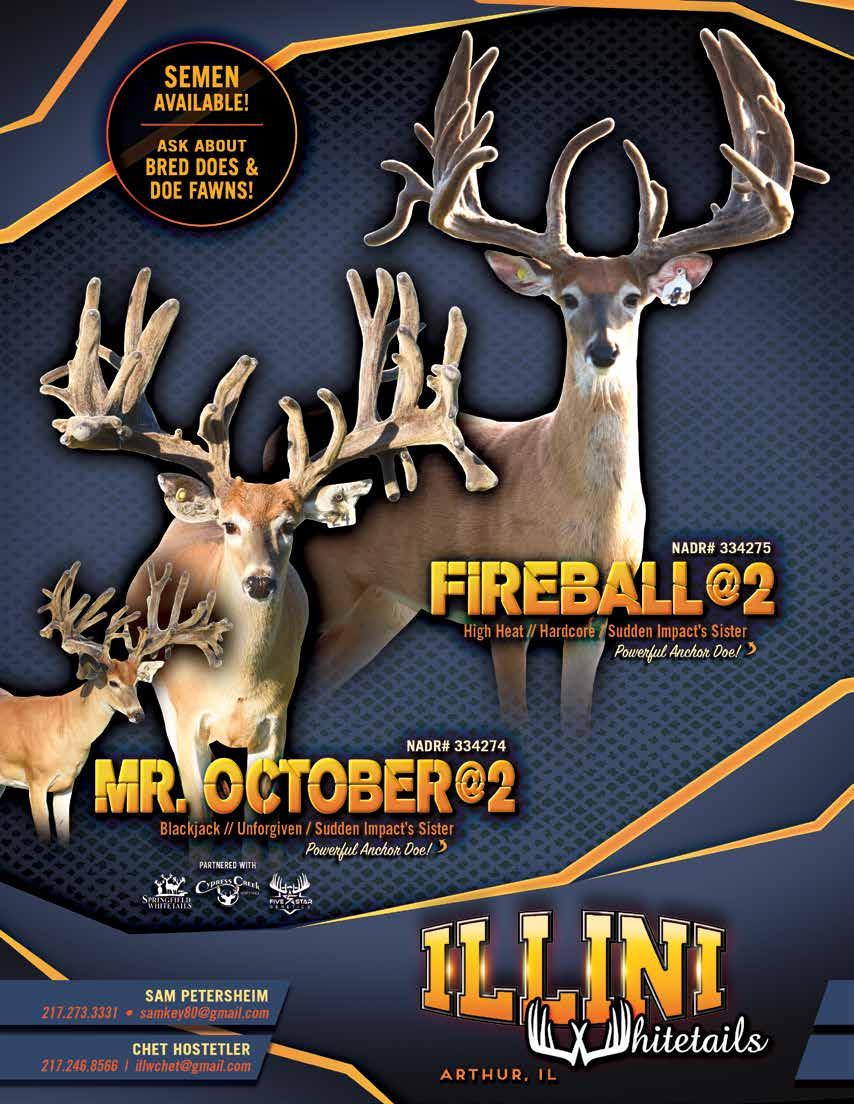

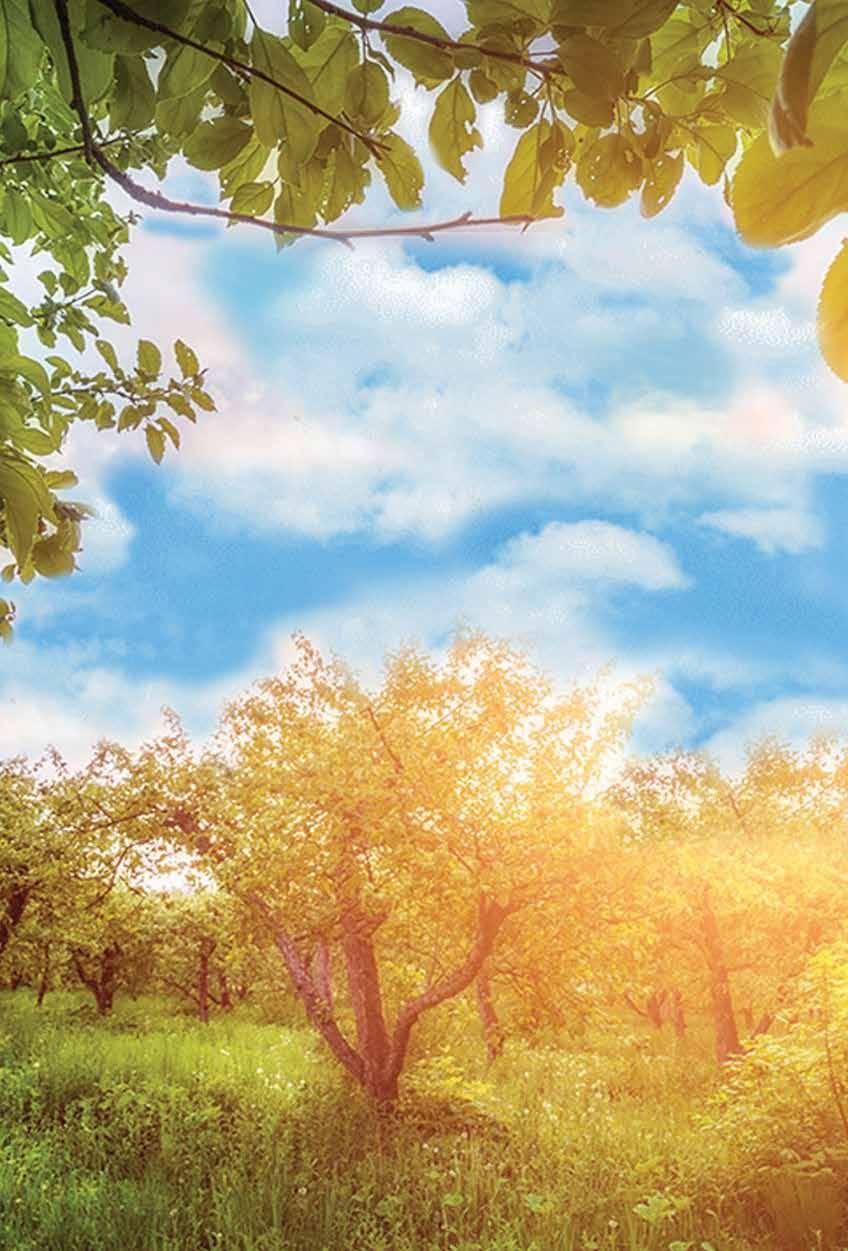
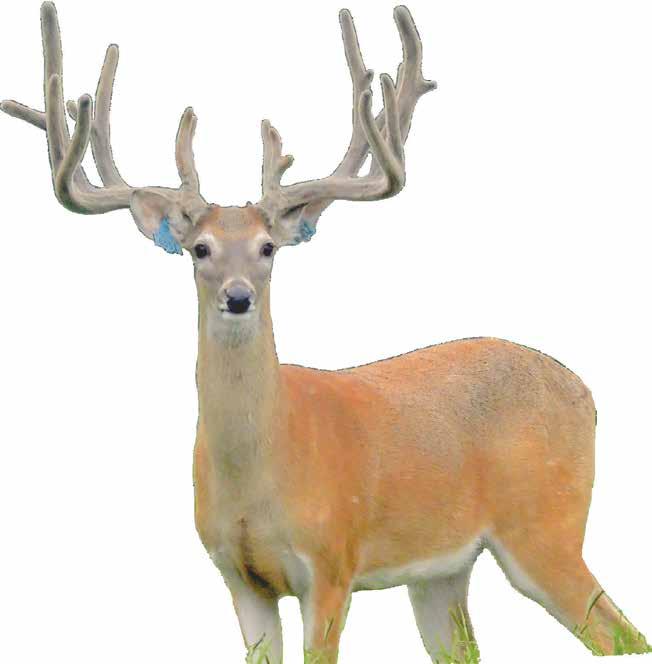
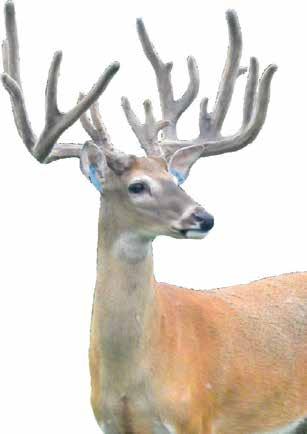

APPLEJACK Black Jack Sunset Ex Thunderstorm SEMEN AVAILABLE Marty & Gina Bontrager 6355S 700W Topeka,IN 46571 260-593-9150 DNA # 357680
Updates from BOAH, May 2023
UPDATES FROM BOAH,
MAY 2023
MOVING CERVIDS TO KENTUCKY? BE PREPARED!
Moving Cervids to Kentucky? Be Prepared!
Cervids travelling to Kentucky are required to have a Radio Frequency Identification Device (RFID) 840 tag. This can be any style of 840 tag provided the tag contains an RFID (microchip). This allows Kentucky officials to scan the tag when the cervids arrive in Kentucky. A secondary farm tag is also required.
Cervids travelling to Kentucky are required to have a Radio Frequency Identification Device (RFID) 840 tag. This can be any style of 840 tag provided the tag contains an RFID (microchip). This allows Kentucky officials to scan the tag when the cervids arrive in Kentucky. A secondary farm tag is also required.
Some producers have had to add an RFID 840 tag in addition to the ear tags already in the ears immediately before movement. Veterinarians preparing the certificate of veterinary inspection (CVI) and the VS 1-27 for cervid movement to Kentucky should record all tags in the deer’s ears.
Some producers have had to add an RFID 840 tag in addition to the ear tags already in the ears immediately before movement. Veterinarians preparing the certificate of veterinary inspection (CVI) and the VS 1-27 for cervid movement to Kentucky should record all tags in the deer’s ears.
Be sure to notify the Indiana State Board of Animal Health (BOAH) of the additional, newly placed RFID tag number. Many recent additions are not listed in BOAH’s database. If all tags are not recorded, traceability can be challenging, if not impossible.
Be sure to notify the Indiana State Board of Animal Health (BOAH) of the additional, newly placed RFID tag number. Many recent additions are not listed in BOAH’s database. If all tags are not recorded, traceability can be challenging, if not impossible.
Secondary farm tags can also be important for tracing cervids and need to be recorded on the CVI and VS 1-27. Ensuring all tags are verified and written correctly on the CVI and VS 1-27 before movement occurs is important to maintaining an export market to Kentucky.
Secondary farm tags can also be important for tracing cervids and need to be recorded on the CVI and VS 1-27. Ensuring all tags are verified and written correctly on the CVI and VS 1-27 before movement occurs is important to maintaining an export market to Kentucky.
Indiana’s ID Requirements
Indiana’s ID Requirements
Indiana requires each cervid have two forms of identification: an official ID tag and a unique, secondary ID. The number format for the types of identification include:
Indiana requires each cervid have two forms of identification: an official ID tag and a unique, secondary ID. The number format for the types of identification include:
• 840 tags and NUES tags: The only official tags for cervids; write the full sequence of digits with no spaces.
840 tags and NUES tags: The only official tags for cervids; write the full sequence of digits with no spaces.
• NUES tags begin with the state code (IN=32) followed by 2 or 3 letters and 4 numbers (example, 32ABC1234)
o NUES tags begin with the state code (IN=32) followed by 2 or 3 le\ers and 4 numbers (example, 32ABC1234)
• Farm management tags: Write the tag color using the three-le\er abbrevia^on (see below), leave a space, then write the tag number (example, YEL 30).
Farm management tags: Write the tag color using the three-letter abbreviation (see below), leave a space, then write the tag number (example, YEL 30).
• Cervid herd tags: Tags begin with cervid herd ID.
o Do not put a color in front of the cervid herd tag number.
Cervid herd tags: Tags begin with cervid herd ID.
• Do not put a color in front of the cervid herd tag number.
o The cervid herd ID should always be included for a complete tag ID.
• The cervid herd ID should always be included for a complete tag ID.
• Use a dash between the cervid herd ID and the individual animal number (example, IN500-0215).
o Use a dash between the cervid herd ID and the individual animal number (example, IN5000215).
EXAMPLES
Tag type
840 tags
8400034561123899
NUES tags Official 32ABC1234
IN cervid herd tags Farm IN639-0123
Farm tags Farm YEL 30
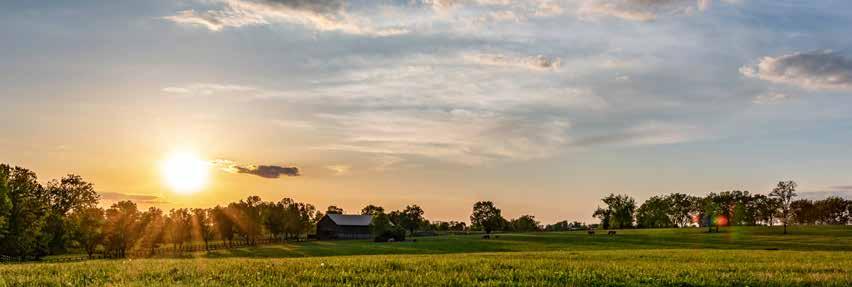
• Bangle tag numbers on an 840 tag should be written separately from the 840 number.
Continued on Page 20...
ID type
Correct format
Official
19
Continued from Page 19...

INDIANA HERD PART OF WISCONSIN CWD TRACE
Within the last year, Indiana was notified by the Wisconsin Department of Agriculture, Trade and Consumer Protection (DATCP) of a CWD traceback exposed deer that originated from an Indiana producer. The Wisconsin herd in which the Indiana deer resided for the past 2 years was in a CWD-endemic area of Wisconsin. According to DATCP, 49 white-tailed deer have tested positive for CWD within 5 miles of the positive herd in Wisconsin. One of these positive deer was within 1 mile of the farmed-cervid herd.
The Indiana herd from which the trace deer originated has completed antemortem and codon testing. After a risk analysis and epidemiologic investigation were completed, the herd was placed under a herd plan with specific requirements for testing and surveillance before CWD-certified status can be re-instated.
This case serves as a reminder to Hoosier producers: When selling deer, consider the risk of where you are selling. Questions to consider include:
• Does the state have CWD in the wild?
• How close is the herd that wants to buy my deer from a CWD diagnosis in the wild?
• Is the herd your deer will be entering a closed herd?
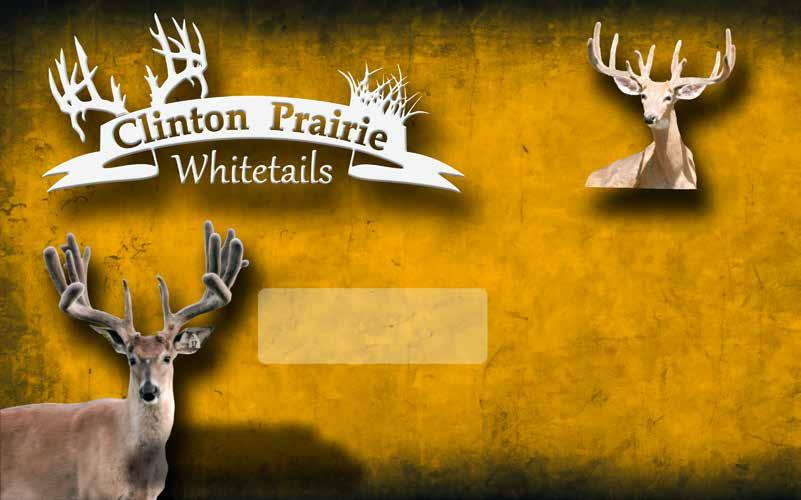
• If my herd is linked in a CWD trace, can I deal with the consequences such as a quarantine and herd plan requirements?
• How long might my deer remain in the herd which it is entering? A breeding animal will pose more risk for a potential traceback because it will remain in the herd longer than an animal sold for hunting.
• Is the benefit worth the risk/potential cost?
Because Indiana continues to maintain a CWD-free status, Hoosier-raised cervids are especially desirable to out-ofstate buyers. The diagnosis—even when the source is not the Indiana herd—can impact the seller as extra attention is focused on assuring the supplier herd is disease-free.
20
CLINTON PRAIRIE WHITETAILS STRIVING TO RAISE WIDE TYPICALS

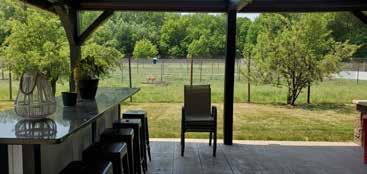
 By: Gail Veley
By: Gail Veley
Sam Wingard wipes the sweat off his brow as he unloads semitrucks and moves inventory from the seat of a forklift. While working as a forklift operator at Jayco is his bonified profession, if given a choice, he’d rather be home with his family and his deer. From deer lover to deer producer, Wingard decided in 2006 to raise deer as a family hobby. “I wanted to do something for the kids, and we hunt a lot, and I just thought it would be cool to have deer,” his story begins. “So, we started Clinton Prairie Whitetails.”
Located in Goshen, Indiana, Clinton Prairie Whitetails is home to 26 deer and counting as fawning season is now in full swing. Clinton Prairie Whitetails focuses on raising typicals with longer tines and wider inside spreads for the stocker market. In an effort to achieve this goal Wingard, 51, purchased the now late Ranger Select and acquired partners on him as well. Now his legacy lives on in the does Wingard has reliably produced for the type of deer he loves to raise. Ranger Select was also responsible for two impressive twin bucks, Wingbo and Yobo, that were later sold at two-years-old. “I always sell
out of deer every year,” he said. “I’m hoping to have a bigger inventory to sell next year. You don’t realize at first what it takes to raise them. It’s a neverending job.”
Following in the footsteps of Ranger Select is Wingard’s current breeder buck, Quick Weapon, bought from Cletus Bontrager. While this time of year may be Wingard’s favorite – when bucks are growing out – he admits other times of the year may not be as fun. “I always get very nervous about darting and loading them,” he said. “Too many things can go wrong.” And while he wouldn’t change the beautiful scenery found at his three-acre farm, if he could, he might change the amount of mud that finds its way inside his deer pens during certain summer weather patterns.
While Wingard appreciates the ability to raise quality deer, he is also grateful to have discovered his “secret” to raising bigger and healthier fawns. “I found a feed at Hideaway Feed Mill that the deer love,” he explained. “Deer love to
eat the fines. They like to eat an entire ear of corn along with the powdery stuff. I discovered if they eat the fines, they grow bigger. That’s where they get their protein from.”
Raising healthy deer along with the support of his family means everything to Wingard. He is grateful for the help of his wife Lorene and for the enthusiasm toward deer shown by his children Keith, Kyle, Colleen and Heidi. In their spare time the family (along with their significant others) enjoys hunting, fishing, sitting around a campfire and firing up the barbeque for a wholesome outdoor meal.
“I’m very blessed to be a part of the deer industry,” Wingard said. “It’s been very good for me and my family. The industry is full of helpful and kind people who want you to succeed.” If anyone is interested in one of Wingard’s bucks, he’d welcome your call at 574312-5071. “If somebody offers me a fair price, I would sell my deer to them.”
21
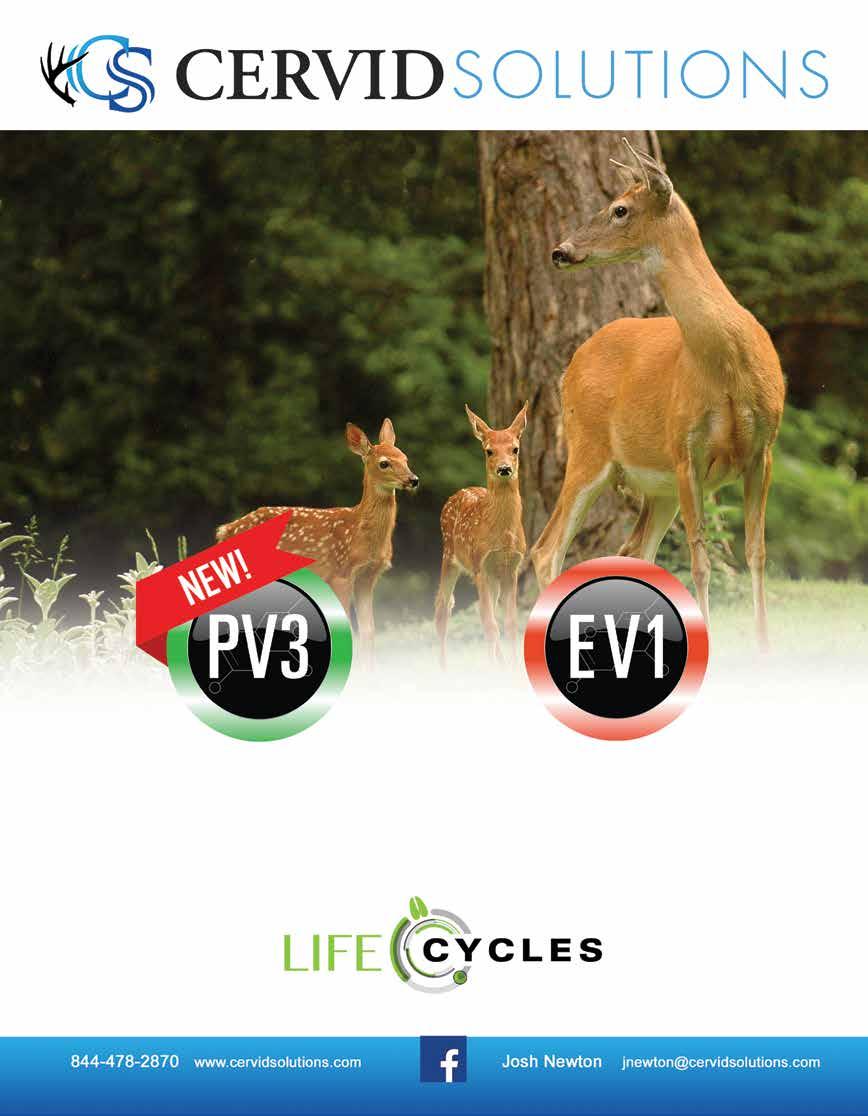

North American Deer Talk
Texas Deer Association Update

The Texas Deer Association has a long history of advocating for whitetail deer and deer rancher's rights. In this conversation the Executive Director of TDA Kevin Davis gives an update on critical information regarding the work TDA is focusing on right now!
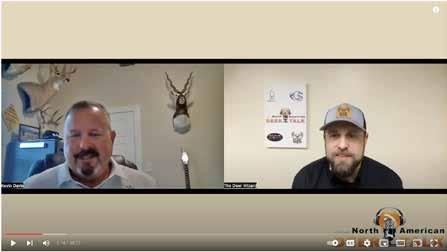

https://www.youtube.com/watch?v=LG5tNT-t9Og
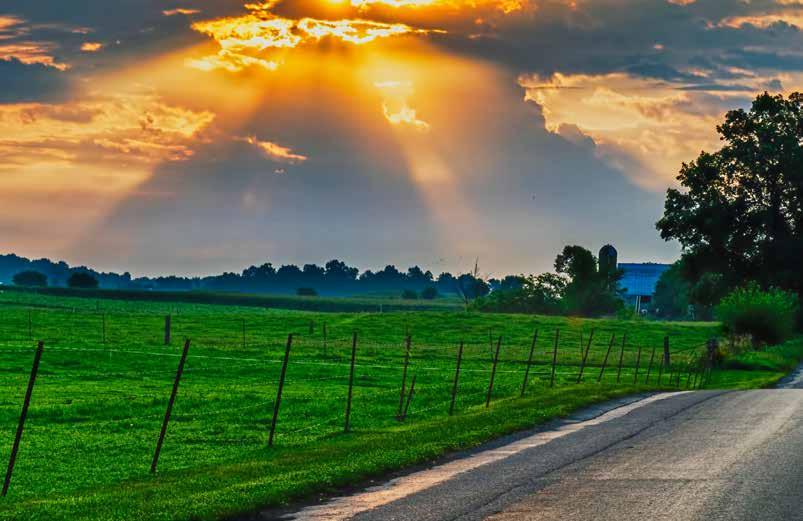
23
FALLOW DEER GAINING IN DEMAND AND POPULARITY
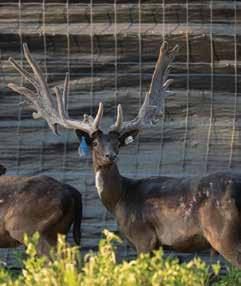

 By: Gail Veley • Sponsored by WOO
By: Gail Veley • Sponsored by WOO
Fallow deer, known for their hardiness, adaptability and apparent resistance to contracting CWD and EHD, are gaining popularity as perhaps a more low-risk animal to raise, compared to whitetails. Although whitetails are and always will remain the Number One animal in North America to hunt, producers and hunters alike are increasingly intrigued by fallow deer with their unique paddle or rack with tines. “I’ve had hunters willing to pay $50,000 to $500,000 for the right fallow buck,” shared Lance Clawson of Caveman Wildlife in Austin, Texas. Credited as being one of the first in the U.S. to raise high-end pedigreed fallow deer, Clawson maintains a herd of approximately 150 in a partnership with Jason Milligan of Cross Canyon Whitetails. Clawson also partners with Chris Ezell on a herd numbering approximately 160 at Ezell’s farm, Dangerous Whitetails of Oklahoma in Adair, Oklahoma.
Originally from Europe, fallow deer were brought to the U.S. during the 19th century as domesticated animals
and as such, no license is currently needed to raise them, said Ezell, who has raised fallow deer for nine years. Having originally bought them to merely help keep the grass “mowed” on his expansive farm, Ezell started appreciating more and more their calmness and their ability to take stressful situations in-stride. Even better was “a combination of three very important things. Their hardiness, they adapt to any environment, are CWD non-susceptible and don’t get EHD,” Ezell emphasized. “They are very efficient animals and usually have only one fawn in June with an unbelievable success rate.”
Clawson, who’s efficiently raised fallow deer for 20 years, first promoted them as a viable choice for hunters from his booth at a Texas Deer Breeders Association show in 2015, after CWD started becoming a more prevalent issue for whitetail breeders in Texas. Pleasantly surprised by the response he received, Clawson said he “just kept going with it.” He began to work steadfast towards developing a registry and later found support through The Exotic Wildlife Association in Kerrville, Texas. “I feel a strong allegiance toward the EWA for coming through for those of us who raise fallows and want to continuously improve them through quality genetics and pedigrees,” Clawson said. More recently, The North American Deer Registry (NADR) began a fallow deer registry as well.
While Clawson, 54, admits he may not be a professional at marketing his fallow deer, he appears to be a professional at producing world-record bucks. “We are creating a species that has never been seen before” said Clawson, whose farm sports
“The 400” Club” with the likes of American Made, Lightening and Bullwinkle, the fallow buck unofficial world record holder. “Everyone who visits our farm immediately wants to go and see Bullwinkle,” Clawson said. “They are immediately drawn to him and intrigued by his size and stature.”
Under the right setting and super genetics, fallow deer racks (or palmate racks as they are called) can be four to six inches wide, Ezell said. “With superior genetics, they could be 10 to 15 inches wide. Fallow deer can also be a variety of coat colors and look different from each other.” Since he began promoting his fallow deer, Ezell has shipped them to states such as Missouri, Kentucky, North Carolina, South Carolina, Virginia, Maine, Wisconsin, Minnesota and Illinois. Using embryo transfer, he and Clawson and Milligan have helped improve the genetics on both of their farms in a continuous effort to make a science out of raising fallow deer. “They are also good eating and big for the meat industry,” Ezell said. “The future for fallow deer is very bright.”
24
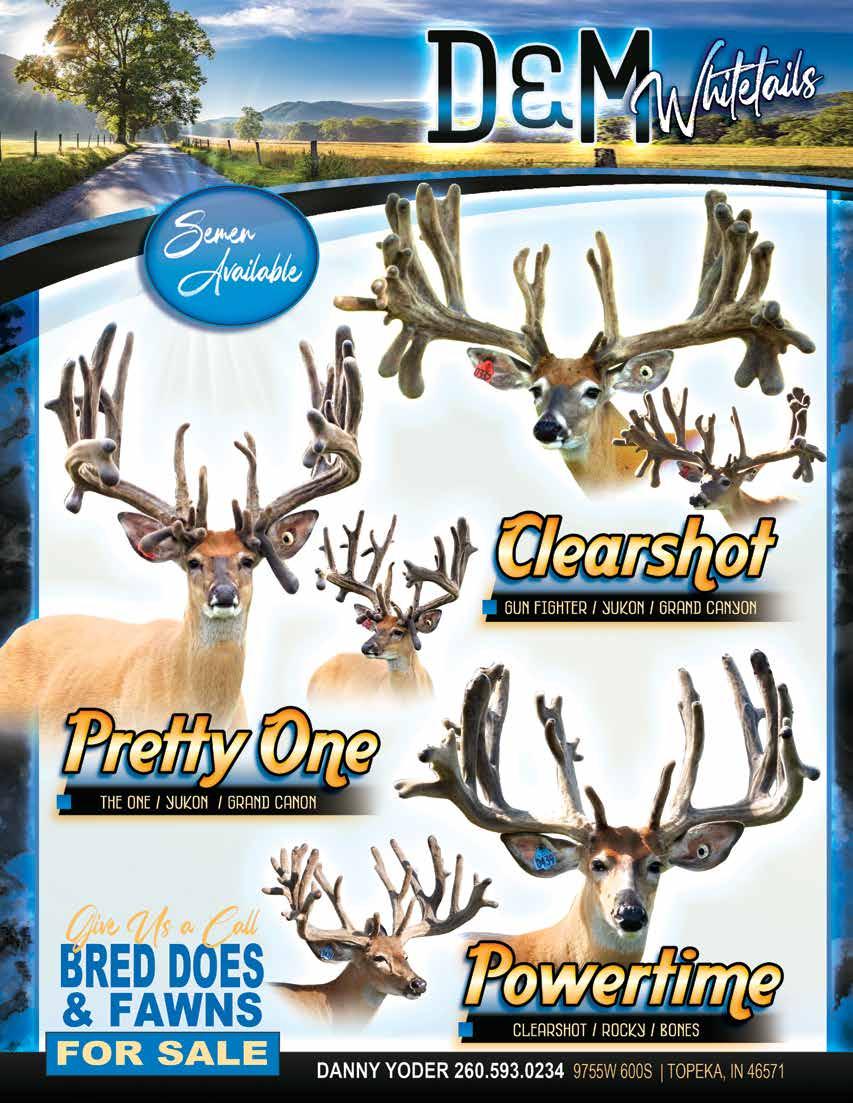

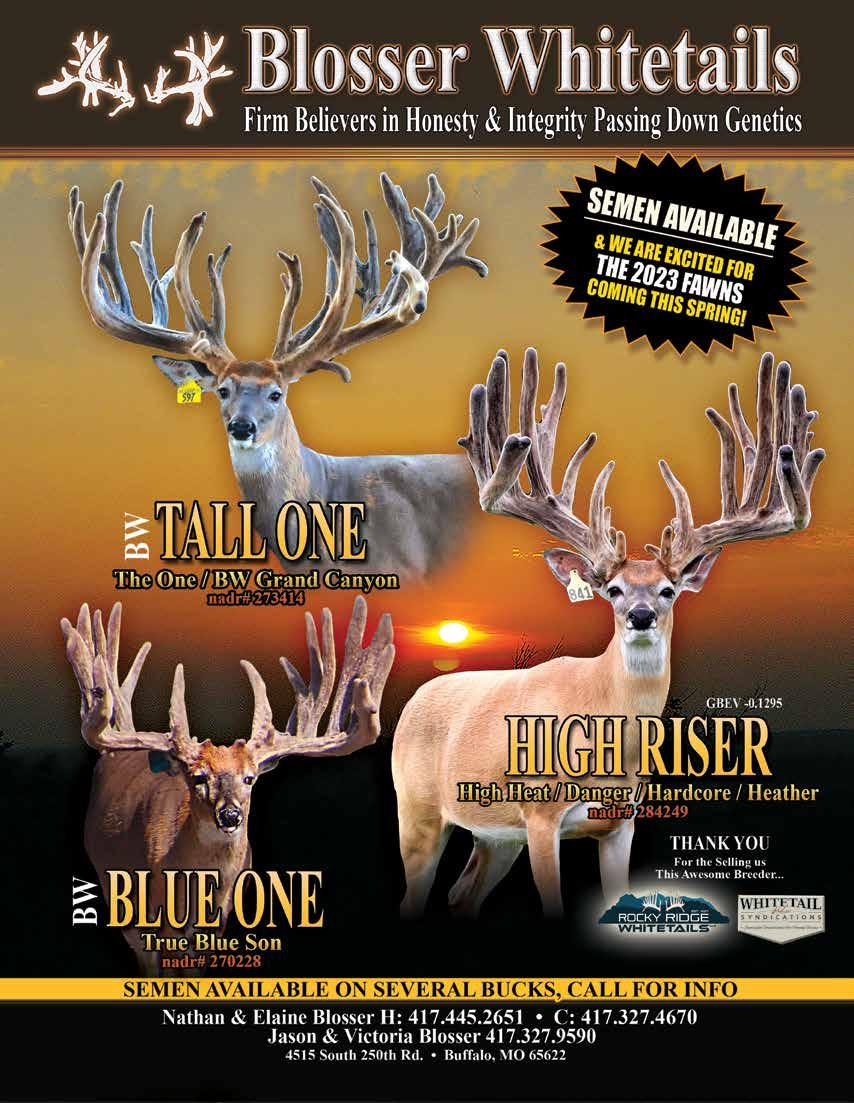
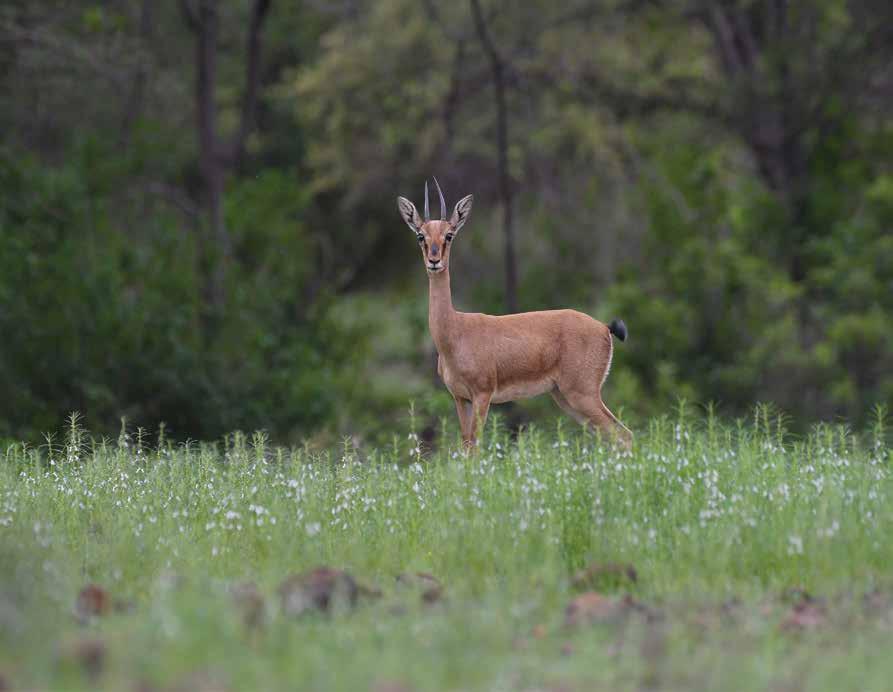








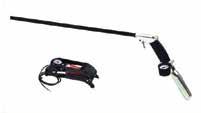




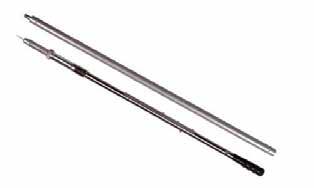

512-920-4757 orders@WildlifeCaptureEquipment.com 979-203-6735 info@DanInjectDartGuns.com HOODS AND MASKS NET GUNS & NETS CARRY RUGS C02 DART GUNS Use as close as 1 yard! Lightweight! Virtually Silent! Low Maintenance Re-Usable! Let our 25+ years of experience in the field be yours

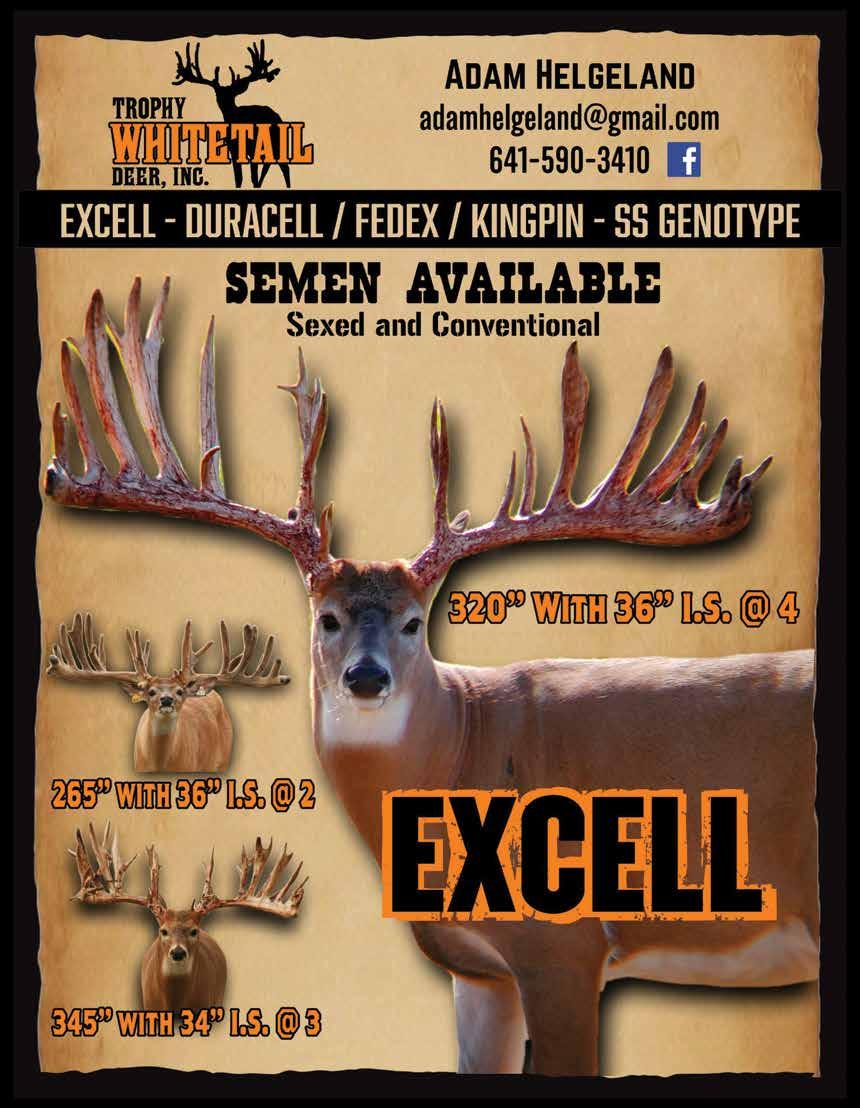

EFFECTIVE BOTTLE FEEDING – TIPS FROM WOODARD WHITETAILS
By: Gail Veley • Sponsored by Kala
Dustin
Blosser
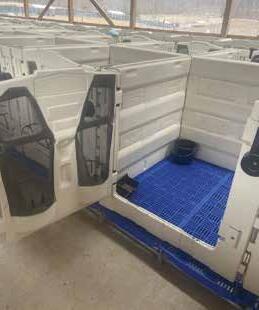
enters the fawning facility at Woodard Whitetails and kneels beside their latest spring arrivals. Blosser, a young West Virginia native, may only be 24, but his experience growing up on a pig, cattle and whitetail deer farm, combined with his maturity, has found him in the role of Farm Manager since September of 2021. Now, nestled inside a calving hutch, curious, eager and hungry fawns come forward, some nibbling at Blosser’s arms, jeans and well-worn leather boots. Sticking his face down to their level, he rubs his hair on their heads to make them realize they are fine. They are safe. Then, with hands outstretched, he carefully gathers one in his arms and offers a bottle, precision filled with milk, and attached to a one-inch goat kid nipple, to what he hopes is a fawn who grows up to live a very healthy life.
While raising a healthy group of fawns requires vaccinations and meticulous care, among other things, it also requires an extensive knowledge on the best and safest way to bottle feed, should your farm practice bottle feeding. After receiving colostrum

from their mother for 24 hours, bottle fed doe fawns are typically pulled and placed on a regimented milking schedule, along with struggling buck fawns and sometimes, a third fawn. While every farm may have it’s preferences on feeding times, Woodard Whitetails suggests bottle feeding at 7 a.m., 11 a.m., 3 p.m. and 7 p.m. for the first seven days. And although fawns will drink as much as you choose to offer, problems can occur if you feed them too much, Blosser explained. “We start out with two to three ounces four times a day during the first week,” he said. “They’ll drink whatever amount you give them and if they have too much, they can bloat or milk can overflow into their rumen, and you can kill them. You want to develop their rumen and they won’t if they aren’t eating and just getting all the milk they can ask for. Another important factor is that from Day One we have water and dirt from their pens inside their hutches to help build their immunities.”
Building a fawn’s immunities along with their desire to eat solid food begins slowly during week two, when the schedule shifts to three times a day at 7 a.m., 1 p.m. and 7 p.m. and more milk is gradually offered to the eventual tune of 12 to 13 ounces per feeding. “By the time week three comes around, we are feeding twice a day at 7 a.m. and 7 p.m. and they are eating more solid food,” Blosser said. “Sometimes they don’t make it all the way through week three because they are getting antsy. We make a practice out of giving them a bottle in whatever will become their permanent pen so that they aren’t losing two things at once while also being put somewhere unfamiliar. If you want to keep them really calm,

it’s better this way.” While most fawns adapt immediately to bottle feeding, occasionally there are fawns that don’t. “Rather than putting stress on them by trying to catch them and force the bottle, I just put them back out with Mom and they do fine,” Blosser said. Regardless of how they were raised from birth, Blosser keeps track of each fawn, taking note of their appetite, stool quality or overall health. Should a fawn have diarrhea, Blosser finds that three cc’s of pumpkin baby food usually straightens it out. “You need to watch being too invasive with antibiotics and overcorrecting things,” he emphasized. “It might just kill all the bacteria in their gut. I like to start at the least invasive point and work my way up and see if it’s working first.”
Fawn survival rate at Woodard Whitetails is usually around 95%, said Owner Henry Woodard. “We may lose 5%. This count includes every fawn whether they were born sick or not. Raising fawns is a labor of love and you are handling them and basically replacing their mother and you become attached. If they are sick and you save them, you felt a bond with them. We wouldn’t have a chance to save them otherwise and bottle feeding can give us the best opportunity to stay on top of things.”
31


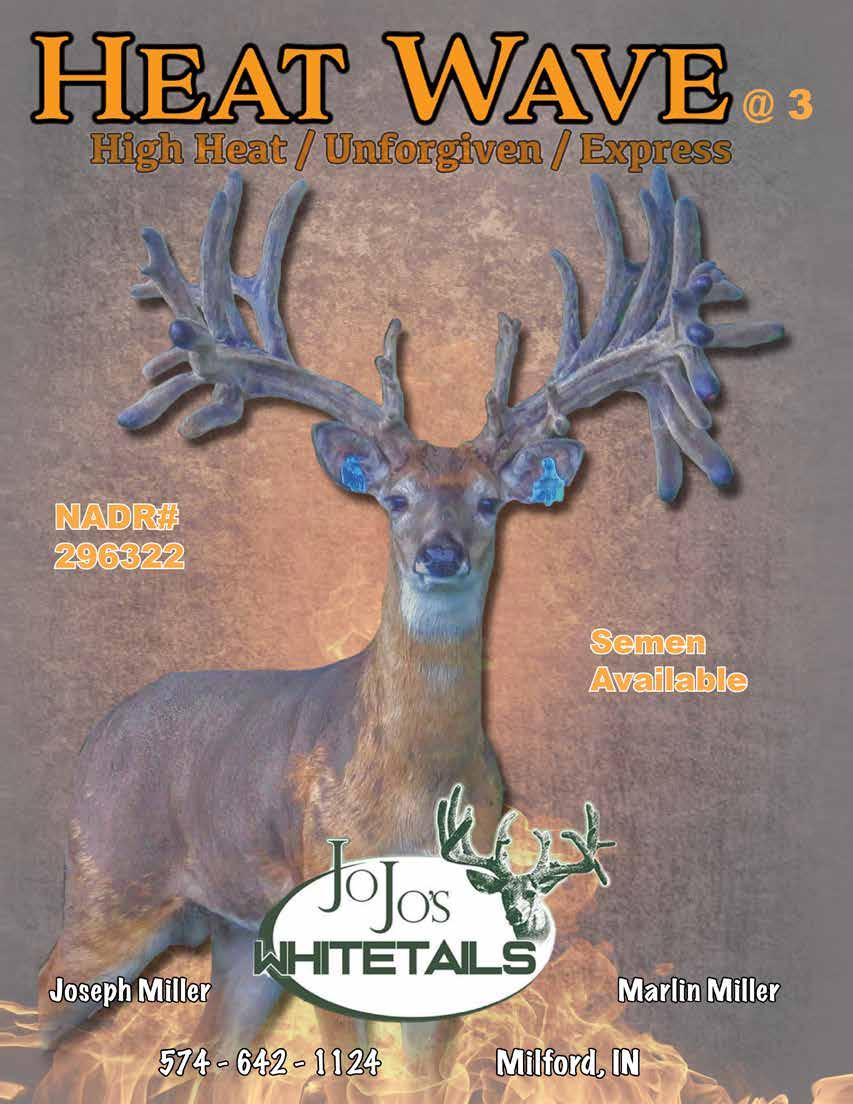
SPRING SALAD WITH VENISON & ROAST RADISHES
By Tristan Henry
The coming of spring calls for a walk, and when green shoots or mushrooms emerge, I start feeling inspired to forage.
It starts with halved radishes and spring mushrooms, roast cut-side down in butter & miso. They’re savory, but slightlysweet and balance the peppery bitterness of freshly foraged spring greens dressed in a tangy yogurt-tahini sauce. Just add a perfectly seared loin of venison and you’ve got a spring meal fit for royalty, but available to all.
IngredIents
• 2 pound venison loin
• 2 pounds radishes with their greens, root ends of radishes trimmed, radishes halved lengthwise
• 8 cups greens reserved
• 1/4 cup white miso paste
• 1/4 cup plain yogurt
• 1/4 cup tahini
• 3 tablespoons unsalted butter, melted
• 1-1/2 teaspoons honey
• 1 teaspoon grated lemon zest plus juice
• 1 garlic clove, minced
• Olive oil

• Salt and pepper
InstructIons
Directions
At least 30 minutes and up to 2 hours before cooking, take a whole venison loin out of the refrigerator and salt liberally.

Heat a well-oiled cast-iron skillet to smoking. Pat your loin dry, pepper and place in your pan until wellbrowned on all sides. When internal temp reaches 120, remove, tent with foil and allow to rest.
Toss halved radishes with melted butter; miso, honey; and a pinch of salt. Arrange radishes cut-side-down on a sheet-pan and roast in a 500 degree oven ‘till tender and and caramelized, about 15 minutes.
Whisk yogurt, tahini, lemon zest and 1 tablespoon juice, garlic, salt and pepper to taste.
Reserve 3/4 of this mixture for plating, with the remaining, add 2 tbsp Olive Oil and 2 tbsp lemon juice and 2 tbsp water & whisk.
To plate: Schmear the yogurt-tahini sauce across your plate. Dress greens, cover with radishes & mushrooms. Slice venison loin in 1/2 inch medallions and arrange across the salad. Enjoy!

35



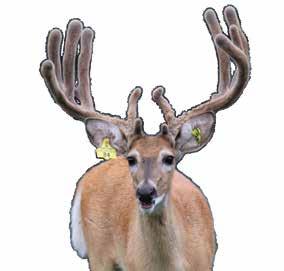

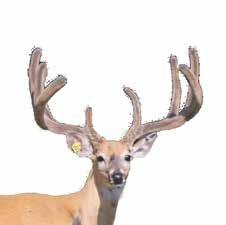
36 Yoder Brothers Whitetails 7755 W. 675 N. Shipshewana, IN 46565 For Fawns or Semen Call 260-768-3207 Tall Typical Tines Half-Time Yearling Quicksand/High Time Doe Yearling Triple T/Argus Doe Sire: Flint Point Dam: King Doe at 3 at 3 Sire: GT Dam: Flint Point Doe Y82 GTT Triple T DO YOU SEE OUR STRATEGY?

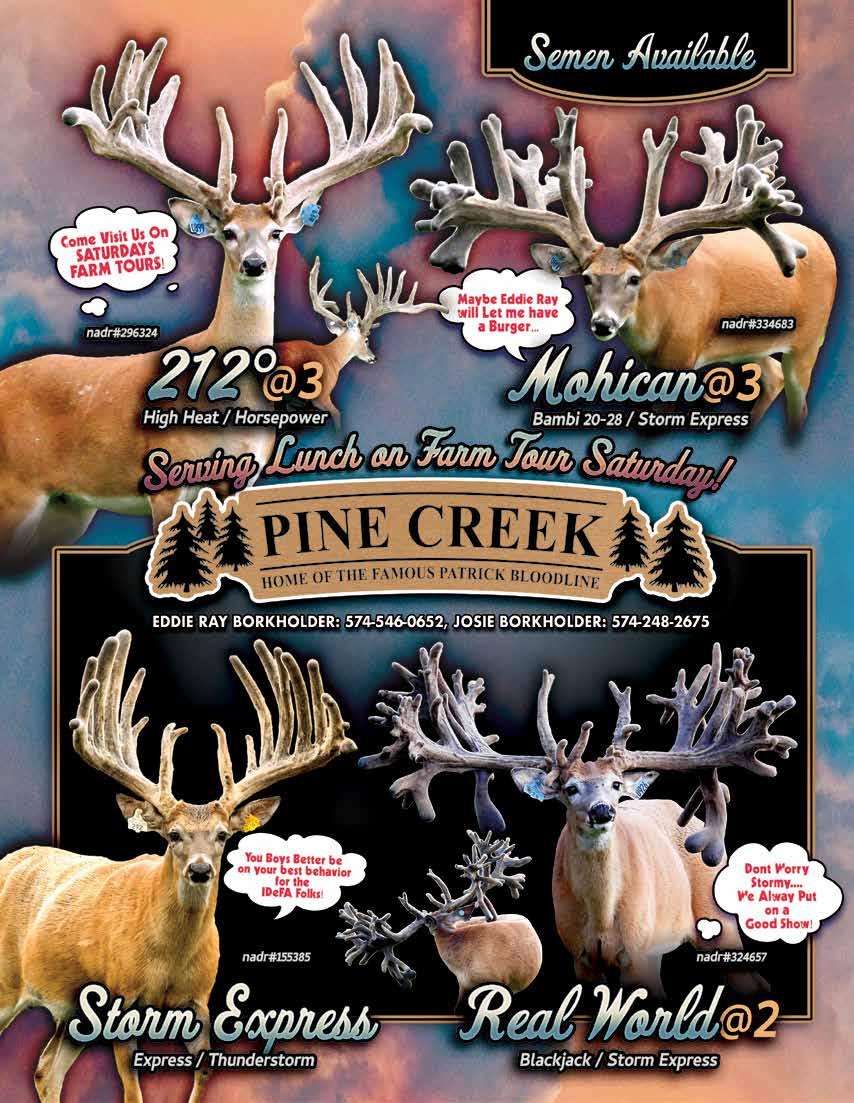
SUDOKU

The rules for sudoku are simple.
A 9×9 square must be filled in with numbers from 1-9 with no repeated numbers in each line, horizontally or vertically.
To challenge you more, there are 3×3 squares marked out in the grid, and each of these squares can’t have any repeat numbers either.
Coloring Activity!

Send in this picture with your childs name and age for a chance to be featured in the next magazine or on our facebook page!
All ages welcome to participate!
Pictures can be emailed to deerassociations@gmail.com or mailed to
Samantha Uchytil
19291 59th St NE
New London, MN 56273
39

FEEDING DIRECTIONS: WHITE-TAILED DEER:
• Fawns up to 1 week of age: Feed 16 oz. of formula daily, divided into 4 – 6 feeding.



• Fawns 1 week to 1 month of age: Feed 24 to 30 oz. of formula daily, divided into 4 feedings.
• Fawns 1 month to 2 months of age: Feed 30 to 35 oz. of formula daily, divided into 2 to 3 feedings.

• Fawns 2 months to weaning: Gradually decrease formula and number of feedings to approximately 15 oz. of formula once daily until fawn is fully weaned at 12 to 14 weeks of age. Provide a weaning diet and fresh clean water to the fawn. For oral use only. These feeding directions are guidelines. As each animal is an individual, the feeding rate may be increased or decreased according to the needs of the neonate.
Feeding directions for other species can be found on our website.

41 Nick Vlamis, President Email: nklc@aol.com www.foxvalleynutrition.com DAY ONE FORMULA Species - Specific for Whitetail, Mule Deer & Elk “Better Than Mother’s Milk” DON'T LOSE A FAWN THIS YEAR TO POOR NUTRITION (847) 687-3200 (800) 679-4666
• All-Milk Protein from Premium Food-Grade Milk Ingredients • Essential Vitamins and Complex Minerals • Balanced Fatty Acids • Improves Digestion • Promotes Growth and Performance • No Refrigeration Needed • Easily Palatable • 18 Month Shelf Life • Available in 20# & 8# pails • 24/7 Technical Advice & Support
FREE business card ads for members of Indiana Deer and Elk Farmers’ Association
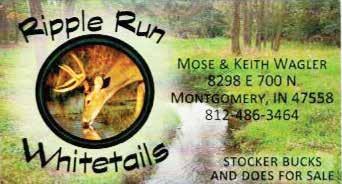

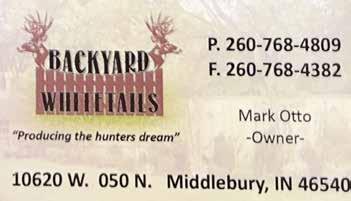

If you would like your farm or business featured on our business card pages, email digital pdf file or scanned image (must be readable resolution) of your business card to the email address below.

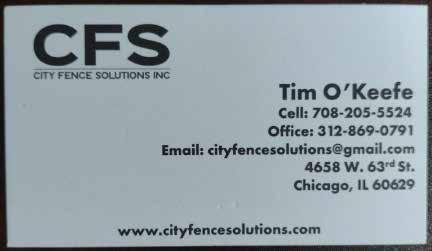
This gives IDEFA members a way to reach out to one another for services and to buy or sell deer! There will be limited pages for these card spreads, first come first serve. The overflow would be placed in the next issue and cards will be rotated each quarter.
Email to:
Erica Bratton
indianadeer@gmail.com


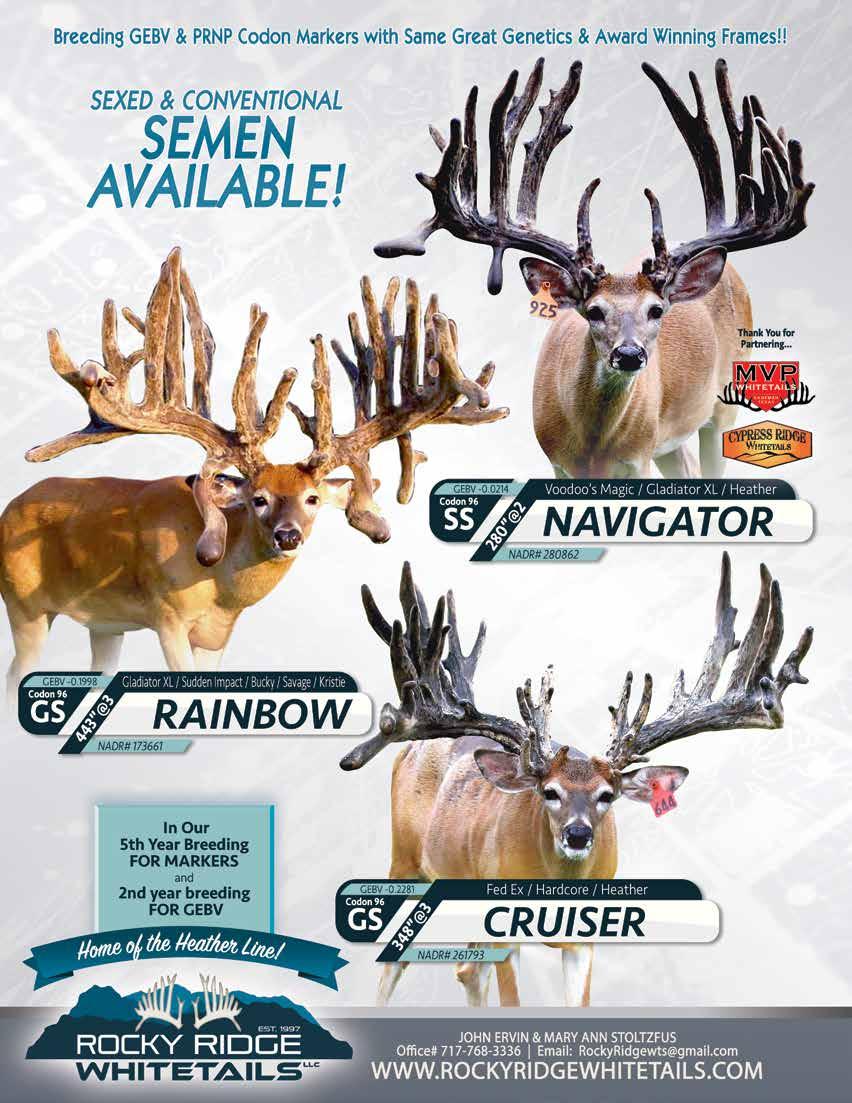
LIGHTER WEIGHT. MORE EFFECTIVE. MINIMAL TRAUMA.

IF YOU HAVEN’T TRIED PNEU-DART’S RDDS, YOU’RE MISSING MORE THAN YOUR TARGET





Did you know impact trauma can negatively influence medical treatment?
We do. Which is why we’ve spent 50+ years perfecting the ideal remote delivery device. Shorter in length and lightest on the market, our disposable RDDs, with patented Slo-Inject technology, provide ultimate accuracy while reducing the potential for problematic hematomas.
Don’t miss your target. Hit it with Pneu-Dart.
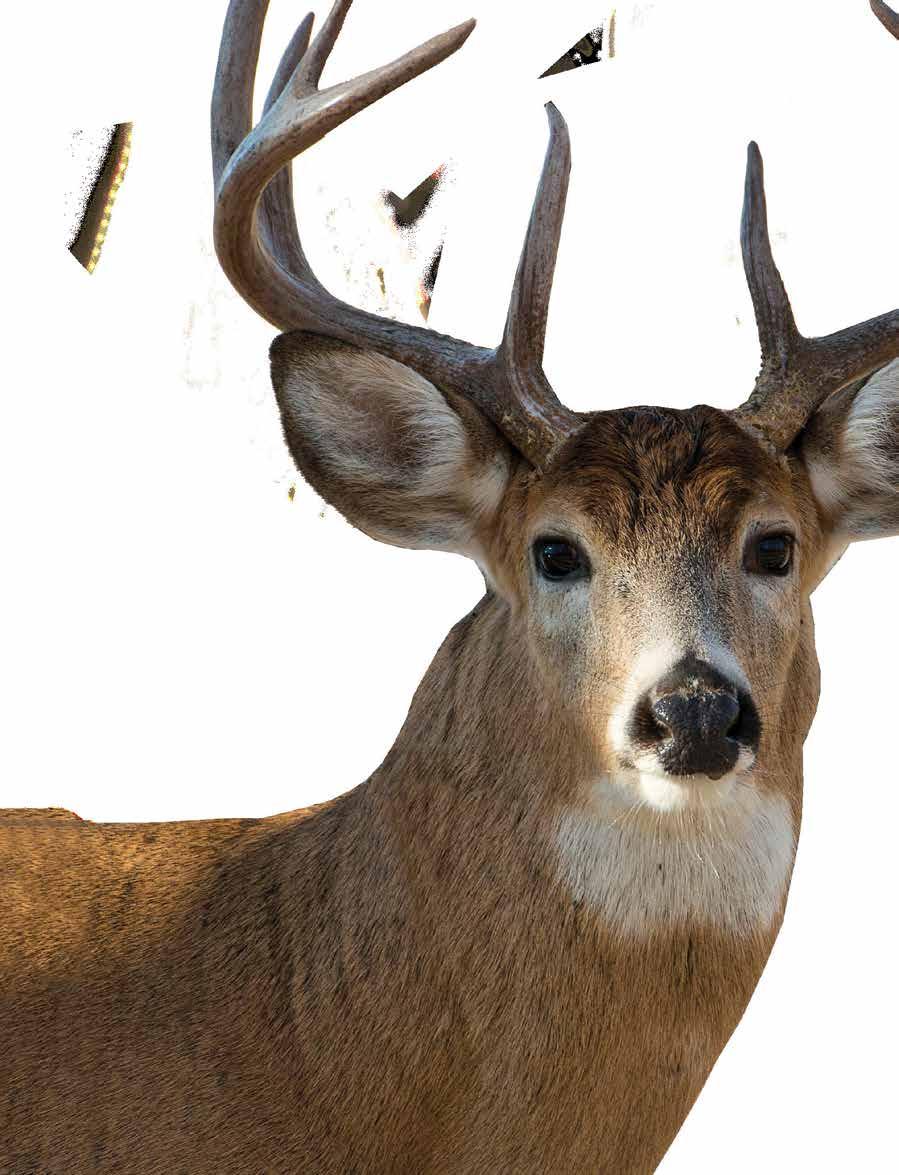

CELEB R ATING OFSE RVICE











PneuDart.com > 866.299.DART

Cinco de Mayo
17. Voyaging
18. Excessive use of power
20. Not lasting long (2 wds.)
22. Mae and Adam
Answers to Sudoku and Crossword puzzles will be available in the next issue, or can be found on our website: www.deersites.com



11. Spring bloom
12. Uproar
13. Rather and Quayle
19. Gulp
21. Corny 24. Sunrise 25. Ringlet 26. Gathers crops 27. Publish 28. Ore beds
30. Gardening implement 31. ____ Gras

Gazes
Golfer’s
47
Across 1. Speck
5. Snoozed 10. Wren, e.g.
14. ____ vault
15. Engraved gem 16. Met solo
23. Work up 24. Performed 25. Matters of little importance
50.
29. Kind of carpet 31. Atlas entry 34. Put back to zero 35. Female pig 36. Bus money 37. Most simple 40. Approve 42. Rotated 43. Eureka! 45. Passion 46. Compass reading (abbr.) 47. A Baldwin brother 48. Beer mugs 49. Peach seed
Fee 52. Bricklayer 55. Astronomer’s tool 60. Unable to read 62. Sinful 63. Amtrak terminals (abbr.) 64. Allowable 65. Judge 66. Lug 67. Cautious 68. Proves human Down 1. Health clubs
2. Elegant 3. Toast spread 4. Small rip
5. Nova ____ 6. Coat part
7. Female ruler 8. Salon treatment 9. Foot part 10. Stationed
slangily
Fine spray
Female singer
Bed support
Sycamore or oak 56. Give up
Done
Dock
Shade trees
Building extension ARMY BATTLE BENITO CELEBRATION COSTUMES CULTURE DEFEATED DIAZ DRESS EMPEROR FIFTH FORTIFIED FREEDOM FRENCH HERITAGE HOLIDAY INVADING LIBERTY MAXIMILIAN MAY MEXICO MUSIC NATIONAL PUEBLA
TROOPS VICTORY VIVA ZARAGOSA
32. Criminal burning 33.
36.
cry 38. Pretzel seasoning 39. “Back to ____ Future” 41. Calendar numbers 44. Area of land 47. Isn’t,
48. Rock band ____ Dan 49. Self-assurance 51. Church feature 52.
53.
54.
55.
57.
58.
59.
61.
TRADITIONAL
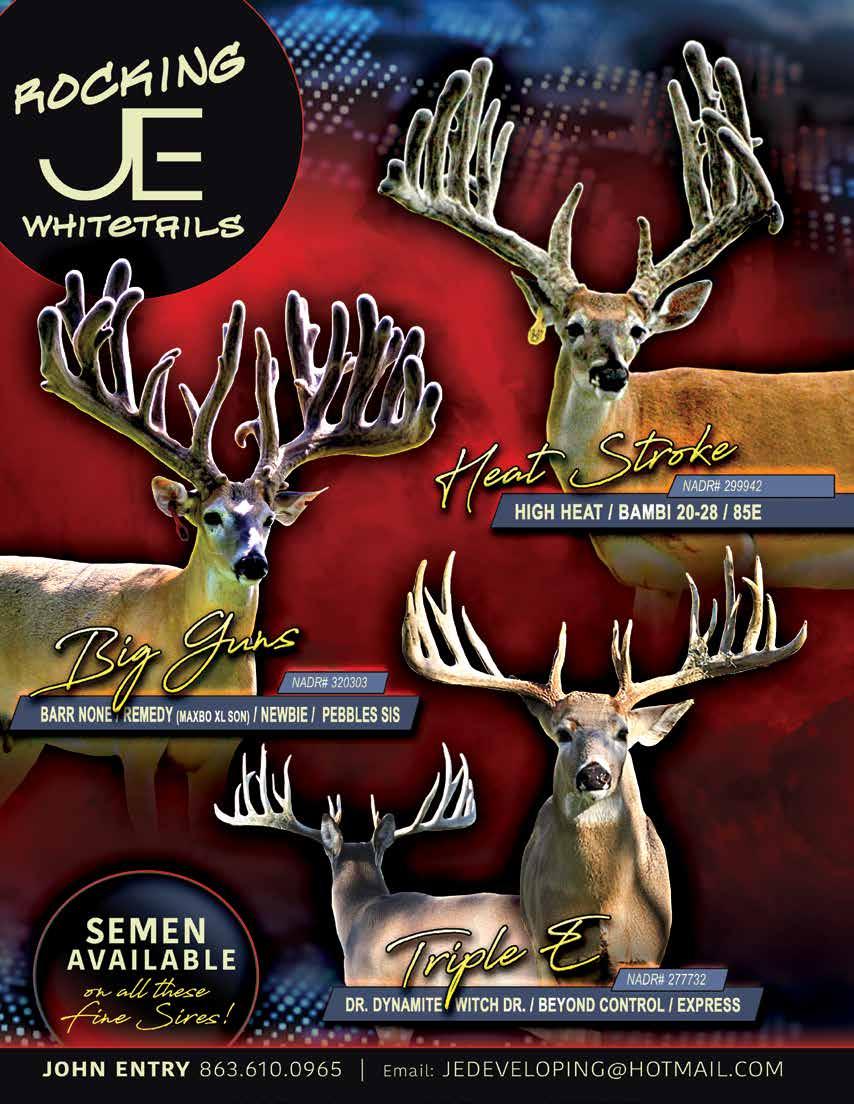
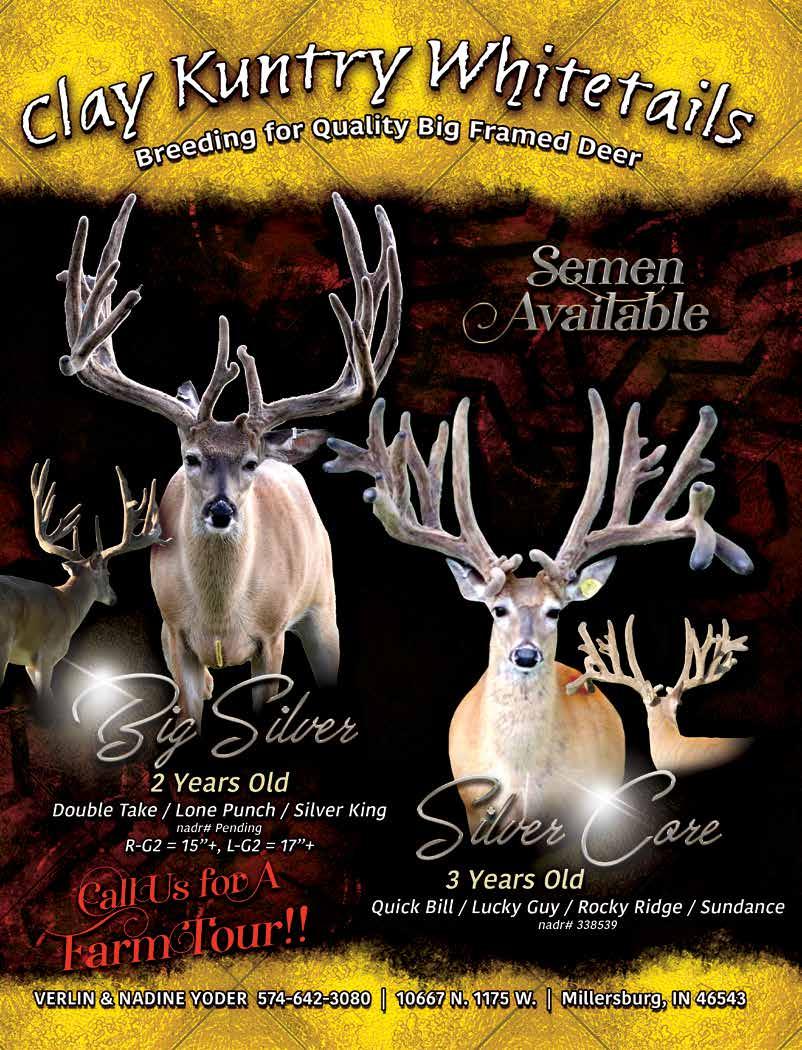
Date: _____________
Indiana Deer & Elk Farmers’ Association
2023 Membership & Information Form
Membership
is
Name:__________________________________________________________________
to
Farm or Ranch Name:______________________
Address:________________________________________________________________
City:__________________________ State:______ Zip:___________County__________
Home Phone:_______________________ Farm Phone:________________________
Cell Phone:________________________ Fax Phone:__________________________
E-Mail:____________________________ Web Site:____________________________


Please circle the any information that you would NOT like published on the IDEFA website or in IDEFA mailings
Are you a current IDEFA member (Y/N)? Member Since ___________

Which species of cervidae do you own?________________________________________
What is your TB, Brucellosis and CWD monitoring status? (list dates):_______________
Circle ALL of the items for purchase at you r farm:
Membership Categories __________ $ 75 Full Membership plus Spouse with Voting Rights __________ $ 50 Full Membership with Voting Rights __________ $ 50 Supporting Membership without Voting Rights
Return Form and payment to: IDEFA-Erica Bratton
IN 46761
50
(first) (last) (Middle)
(first) (last) (Middle)
Spouse:_________________________________________________________________
VAP –
EB –
A – Hard Antler &/or Products TW – Trophy/Mature
H – Hides TB –
E – Equipment
VM – Venison &/or
F – Feed EM – Elk Meat &/or
Animals HP – Hunting Preserve Other RR – Restaurant/Resort P – Deer/Elk Photographs
SC – Scent Collection WB – Whitetail Breeding Stock
Velvet Antler Products
Elk Breeding Stock
Whitetail Bucks
Trophy Bulls
& Fencing
Venison Products
Meat
1050 N 600 W LaGrange,
year
January 1
December 31 Office Use Only Cash Check Credit Bidder Check #________ Bidder # ________


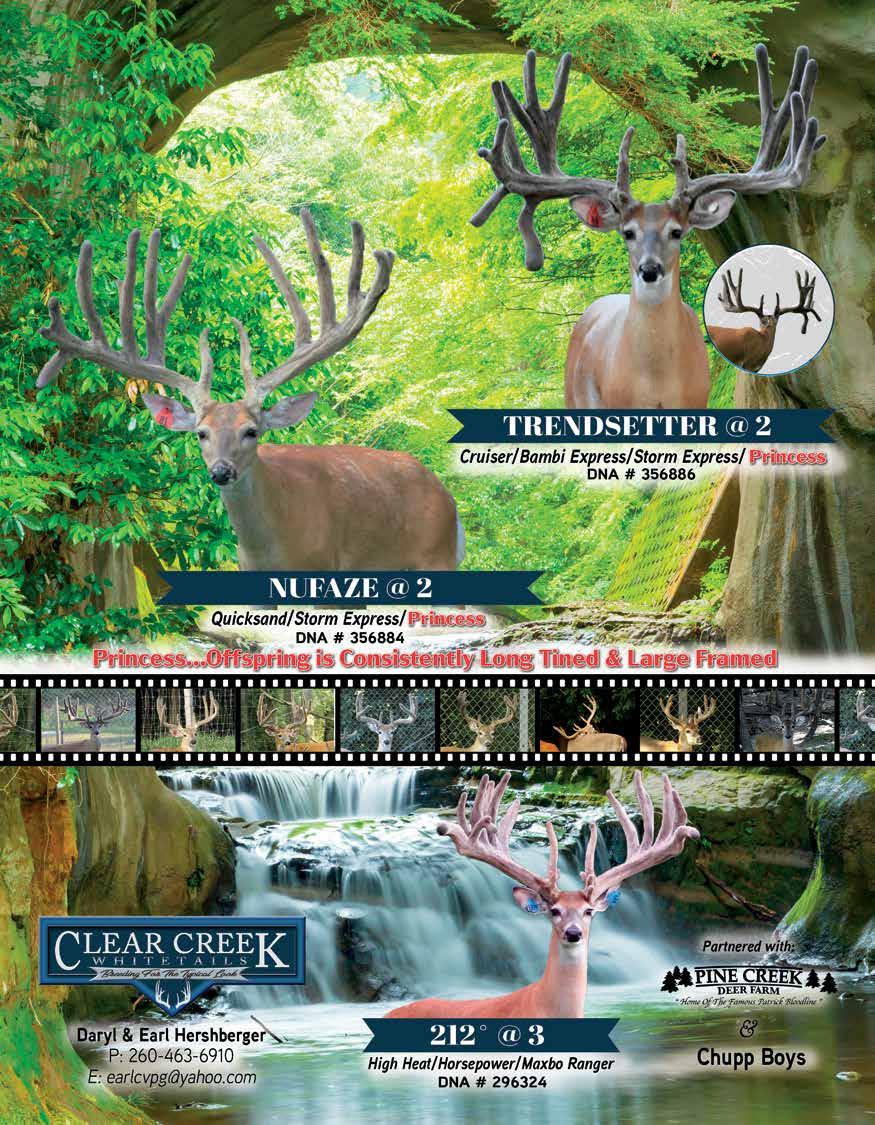
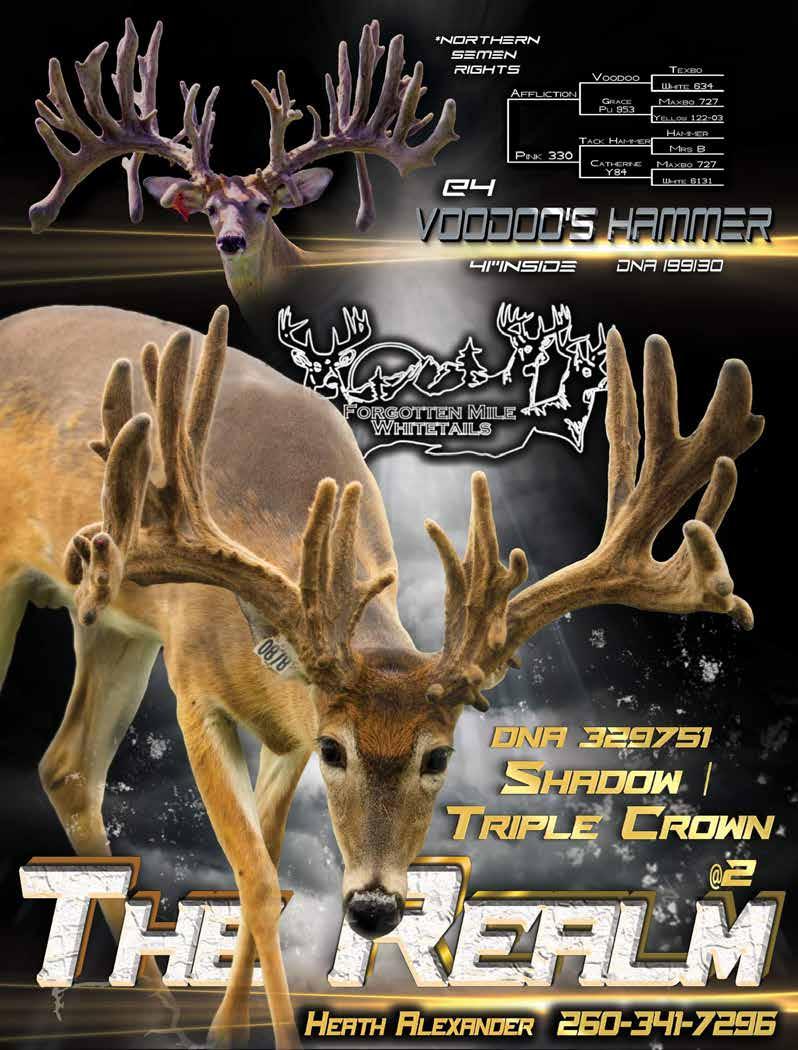
INVEST IN SEMEN STRAWS WISELY AND THOUGHTFULLY
By: Gail Veley • Sponsored by UDFOM
Any deer farmer who’s bought semen straws for the last five to six years more-than-likely “has too much semen,” explains Alex Draper of DD Deer Farms in Clio, Michigan. Although semen straws allow a deer farmer to breed with perhaps the best buck on the market, that same buck may be replaced by another the following year with even better and more desirable traits, making semen straws of the previous year’s buck obsolete. “If you bought more semen from a buck than you can use in one breeding season, you may have wasted your money,” Draper advised.
Individual semen straws, which can vary greatly in price depending on the buck, typically cover two to three does through vaginal A.I. or one to two does through the use of an insemination gun. And while diversifying genetics can be the focus of a deer farmer each breeding season, Draper, 71, a deer farmer of 32-plus years, cautions to study conception rates and to consider your budget and goals beforehand. Should your budget allow for five semen straws, buy five of the same buck you desire to breed to, rather than one straw from five different bucks. “If you only buy one straw from one buck, and you only end up with one surviving fawn from that straw that dies later in the fall, you’ve lost the genetic potential of that entire straw,” he said. “Buy enough to make a difference. It’s better to make sure you end up with the offspring you were after. When you are buying semen, you also need a good grasp on genetics and should breed for paper (pedigrees) or better genetics going forward.”
However, even though keeping up with industry trends has it’s advantages, Draper, whose focus in the past few years has been on raising typicals, is
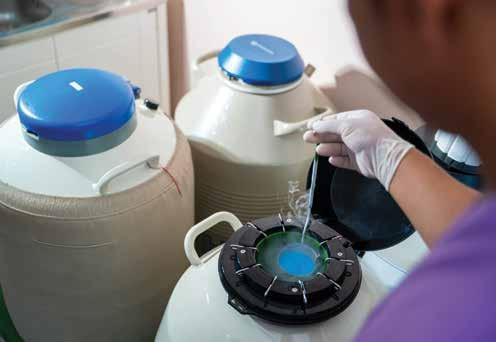
now charting a different course for his farm. This fall and in subsequent years to come, he will be focusing on genetic breeding values (GBV’s) which estimate an animal’s genetic merit for a particular trait and while defining the superiority or inferiority of it’s offspring. In the case of whitetail deer, Draper along with other deer farmers, are realizing the increased need to breed for CWD resistance. To this end, Draper may use some of the semen straws from his old inventory to help perpetuate this goal. “Be aware that some big bucks on the scene now have no GBV’s,” he said. To date, as a result of making informed choices about the purchase of semen straws, more than half of the breeder bucks on Draper’s farm possess the “SS” allele or better. Through his studies, Draper has found he likes “K’s” and “H’s” and anything equal to the “SS” allele but without a “G” link to it. Alleles, defined as one or two alternative forms of a gene that arise by mutation and are found at the same place on a chromosome, may strongly determine a whitetail’s potential resistance to CWD.
“Don’t get me wrong, I like my typicals, but most of the stuff that has favorable GBV’s has a more nontypical look,” explained Draper, whose background and professional engineering career centering around science is influencing him to move away from typicals, and later go back to them when genetics are more favorable and able to sustain many generations of CWD resistant deer. “Here in Michigan, we look it at as a long-term goal and can start with the base that we are creating,” he said. “The science side of me is making me want to focus on the breeding markers and leave a good foundation (legacy) for others to benefit from. It’s not about chasing pedigrees but about the markers. Michigan has a good stocker buck market to move us a couple years down the road. Our ultimate goal is to develop our breeding operations to have all great markers and develop the GBV’s that protect against CWD for future sales of those protected deer.”
54


Storm Express / Express / Silver Hawk 6.5 PRC HILTY WHITETAILS Noah & Sarah Hilty South Whitley, IN 260-248-1684
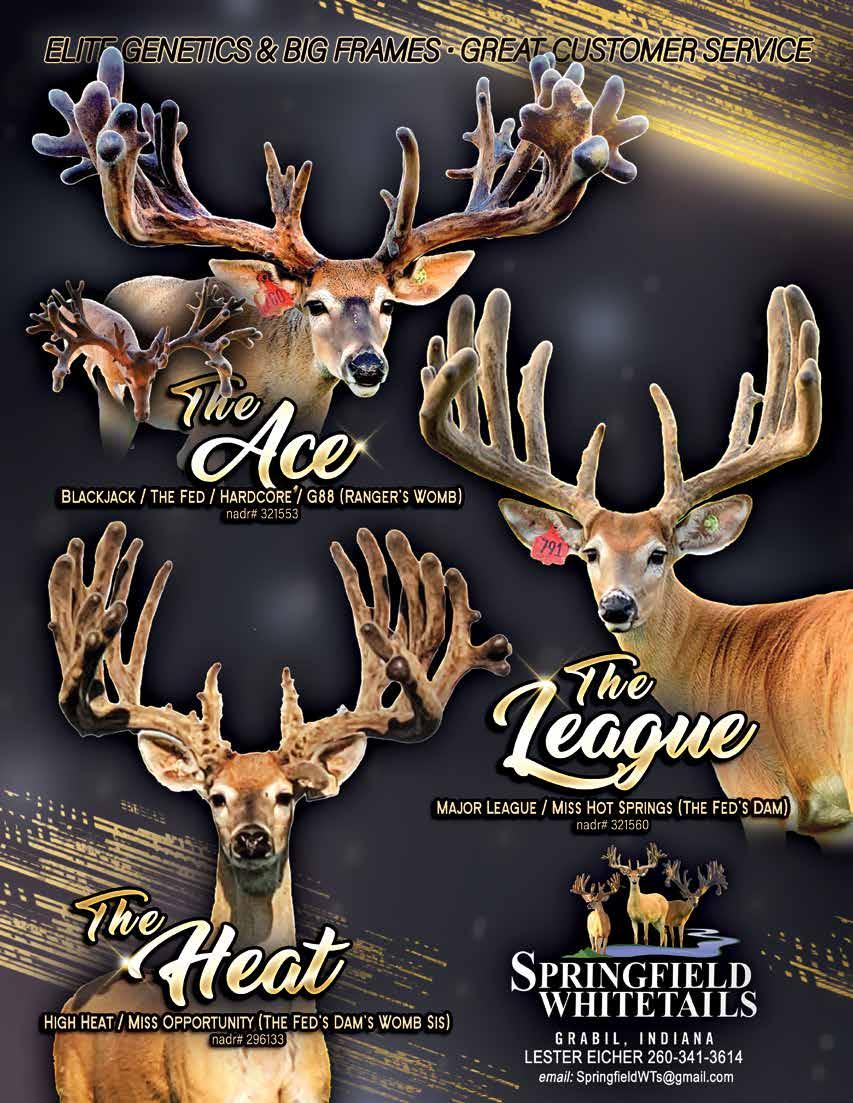

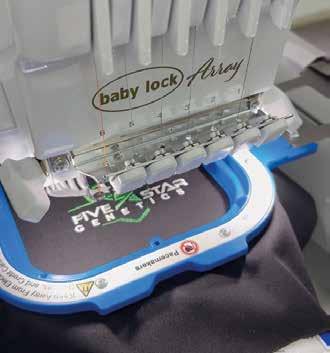




57 Mary Volk “The Mask Lady” 320.232.7493 cuddliez@outlook.com Deer Masks • Caps • Koozies • Apparel Custom Embroidery

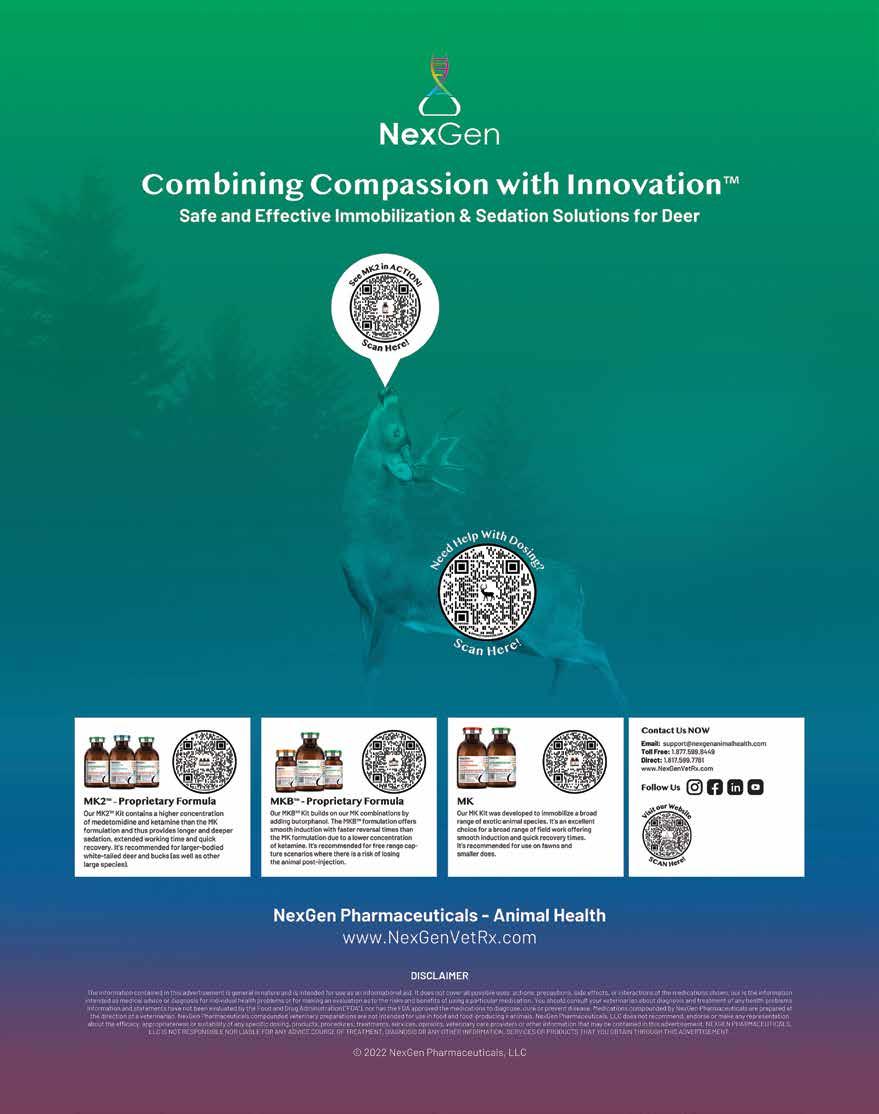
NECROPSY SUBMISSION FORM
Indiana Animal Disease Diagnostic Laboratories
ADDL at Purdue University
HEEKE ADDL - SIPAC
406 S University St 11367 E Purdue Farm Road
West Lafayette, IN 47907-2065 Dubois, IN 47527-9666
P: 765-494-7440 F: 765-494-9181 P: 812-678-3401 F: 812-678-3412
VETERINARIAN:
Name
Dr. Jeff Pyle
Indiana License #
Clinic Address City, State, ZIP
24004598
Phone Fax
Manchester Veterinary Clinic 11798 North State Road 13 North Manchester, IN 46962 (260) 982-6673 (260) 982-8200
Results: Fax Email
Additional Results by:
Email Fax
jbpyle@fcremc.coop springfieldwts@gmail.com (260)768-9182
OWNER:
Name
Address City, State, ZIP
Bill to Veterinarian Bill to Owner (Phone)
ANIMAL: Site/Farm/Unit Address City, State, ZIP
Site/Farm/Unit Phone
SIGNATURE FOR REGULATORY SUBMISSION: Veterinarian

HISTORY: Clinical Problem: Respiratory Enteric Neurologic Reproductive Other
Age _____ day wk mo yr # On Site _____ # In Affected Group _____ # Sick _____ # Dead _____ Breed ____________
Animal ID Weight ____________ Date & Time of Death _______________________________
Cause of Death: Natural / Euthanasia - If euthanized, method used: ______________________
Were barbiturates used? Yes / No - If chemical euthanasia, chemical(s) used: ________________
I certify that the animal has not been exposed to a level of chlorinated pesticides or PCBs in excess of regulatory limits for animals. As the responsible party, I certify that the above information is accurate and true.
Signature and Date: ___________________________________________
***Testing is approved for Mycoplasma spp. PCR on any respiratory case. If identified, lung tissue is to be forwarded to Newport Labs with the IDEFA Newport submission form on file. ***CWD samples will be collected and tested on all cervidae greater than one (1) year of age.*** Please perform culture and sensitivity on tissue samples submitted or tissues that are visibly diseased at time of necropsy. Also perform parasitology testing.
ATTENTION IDEFA MEMBER: Once results are released to above destinations you will be entitled to your reimbursement from IDEFA
Differential Diagnosis or Disease(s) Suspected _________________________________________________________________________________________
Legal/Insurance
Rabies Suspect (County) _______________________________________
Standard Necropsy Abortion Protocol
Species:
Aquatic
Avian
Bovine
Camelid
Canine
Caprine
Cervid
Equine
Feline
Ovine
Porcine
Other
Sex:
Male
Female
Male - Neutered
Female - Spayed
Cremation:
Pets Remembered (ADDL-WL Only)
Pet Rest
Individual Cremation
Group Cremation
Ashes Returned To:
ADDL/HEEKE
Owner
Vet Clinic
Client of Cremation Service?
Yes No
The owner of the animal or any agent acting with the express authorityof the owner agrees that the specimens have been submitted to ADDL and will be handled by ADDL in accordance with ADDL testing procedures, policies, and fees. This handling will include all specified testing and safe disposal of the animal’s remains. Specimens and derived isolates become the property of the Indiana ADDL and may be used for teaching or research purposes. The owner expressly consents to such use. In addition to the testing specified above, additional testing may be done: 1) to meet state or federal surveillance programs, 2) by order of state or federal animal health officials, or 3) when a Foreign Animal Disease is suspected. This form only lists frequently requested tests. For the complete list of tests, consult the ADDL Fee Schedule. Visit
CF.929
60
us at www.addl.purdue.edu
Necropsy Submission Form 11/22/2019
ADDL USE ONLY # PAGES: DELIVERED: ARRIVED: CONDITION: UPS Chilled Good FedEx Frozen Broken Jar DHL Room Temp Leaked USPS Cold Pack Exp Mail Dry Ice Drop-Off None ADDL
BARCODE
PREMISE ID BARCODE
Premise ID
Fund
Purdue
RIO/SIO ••••••••••••••••••••••••••••••••
Bill to Third Party (Name/Phone)
� � � � �
Whitetail Deer
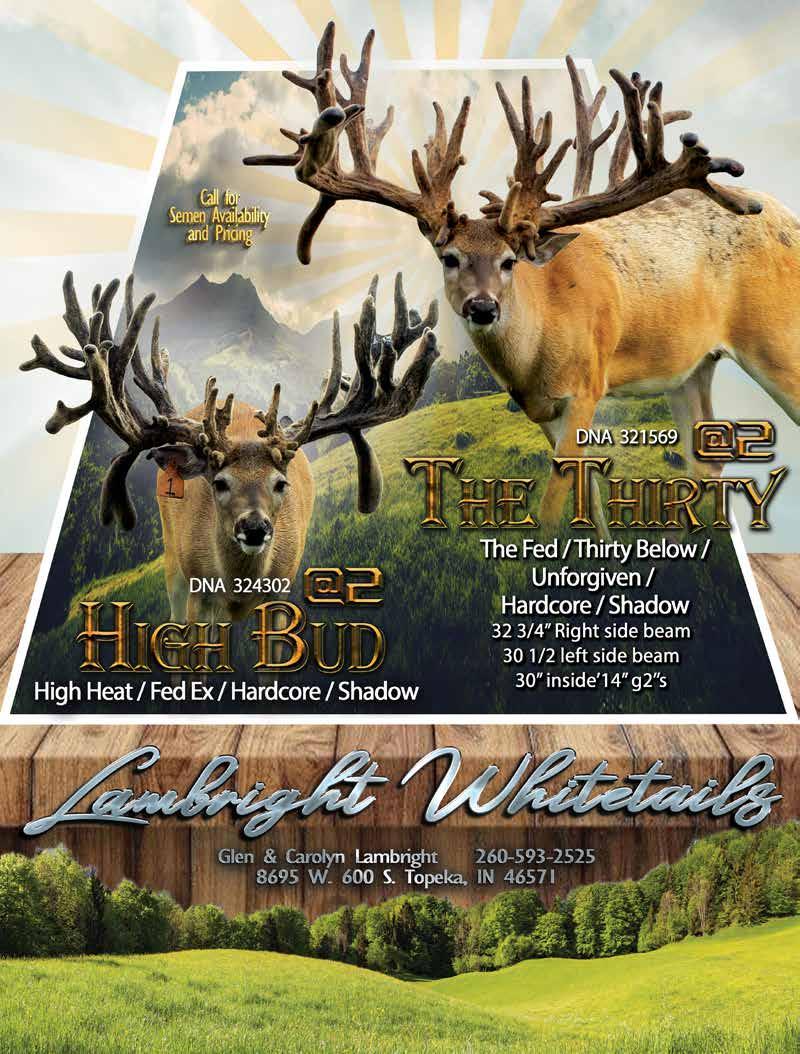
















 Administrative Secretary
Administrative Secretary








 By: Gail Veley
By: Gail Veley






 By: Gail Veley
By: Gail Veley































 By: Gail Veley
By: Gail Veley








 By: Gail Veley • Sponsored by WOO
By: Gail Veley • Sponsored by WOO




















































































